
THE MAC ULTRA FAMILY
















I‘m sure others will relate, but 2022 so far has been an entire year of me asking the TPi team, ‘How did we do this again?’ For two and a half years as we trudged through lockdown after lockdown, living from deadline to deadline. Now it feels like we’re back to some sense of regularly scheduled programming, and once again, beginning the juggling act of live tour coverage, festival site visits, print deadlines and tradeshow preparation. Some may say it’s like riding a bike, which may be true – in the sense that I’m bound to fall off a few times. After all, what’s life without a bit of danger?
On t he topic of regular scheduled programming, we have now launched TPi Awards 2023 and are in the midst of cooking up yet another stellar production. Early Bird tickets to see the show are now available – my advice, book in advance to get the best deal possible!
Away from awards preparation, Jacob and I have been out and about bringing you the latest from the very busy industry this summer. Jacob embarked on his first stadium show visit since 2019, witnessing John Frusciante rejoin Red Hot Chili Peppers on their latest world tour [p20]. The band’s production created an impressive LED ‘wave’ that extended over the band and certainly left RHCP loyalists satisfied. On that same weekend, I got to take Fran to her first-ever Glastonbury. As well as celebrating her birthday, we met up with a host of industry friends over three days at Worthy Farm. Hear all about our adventures on p32.
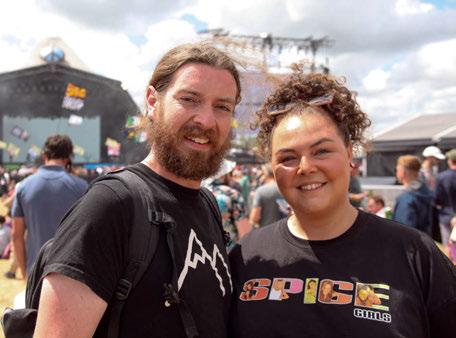
We’ve also made a conscious effort to bring you coverage outside of UK borders. Namely, Indochine’s jaw-dropping in-the-round stadium tour (p52) and Jacob’s tour of Las Vegas’ largest dry hire firms and rental houses to discover how Sin City is recovering from the pandemic. While in Vegas, he paid a trip to AREA15 to witness HOLOPLOT, Lightware Visual Engineering and Powersoft technology delight Illuminarium audiences – a truly outof-this-world experience (p10). I hope you enjoy this issue and I’m sure we’ll see you on the tradeshow floor or on the road sometime soon.
Until then, Stew Hume EditorEditor Stew Hume Tel: +44 (0)161 476 8360
Mobile: +44 (0)7702 054344 e-mail: s.hume@mondiale.co.uk
Assistant Editor Jacob Waite Tel: +44 (0)161 476 8360 Mobile: +44 (0)7592 679612 e-mail: j.waite@mondiale.co.uk
Digital Content Manager
James Robertson Tel: +44 (0)161 476 8360 Mobile: +44 (0)7725 475819 e-mail: j.robertson@mondiale.co.uk
Senior Account Manager
Fran Begaj Tel: +44 (0)161 476 8360
Mobile: +44 (0)7852 336728 e-mail: f.begaj@mondiale.co.uk
Account Manager Matilda Matthews Tel: +44 (0)161 476 8360 Mobile: +44 (0)7413 555978 e-mail: m.matthews@mondiale.co.uk
Editorial Director Peter Iantorno Tel: +44 (0)161 476 8360 Mobile: +44 (0)7763 233637 e-mail: p.iantorno@mondiale.co.uk
Chief Executive Justin Gawne Tel: +44 (0)161 476 8360 Mobile: +44 (0)7768 850767 e-mail: j.gawne@mondiale.co.uk
Accounts Lynette Levi / Sarah Miller: ar@mondiale.co.uk
Mondiale Group Chairman Damian Walsh
Graphic Design & Production Dan Seaton: d.seaton@mondiale.co.uk Mel Capper: m.capper@mondiale.co.uk
Cover Photo Red Hot Chili Peppers Photo: Mike Gray
Printed By Buxton Press • www.buxpress.co.uk
Annual subscriptions (including P&P): £42 (UK), £60 (Europe), £78/$125 (RoW).
Subscription enquiries to: Subscriptions, Mondiale Media Limited, Strawberry Studios, Watson Square, Stockport, SK1 3AZ, UK. Tel: +44 (0)161 476 5580 Fax: +44 (0)161 476 0456 e-mail: subscriptions@mondiale.co.uk www.tpimagazine.com www.tpiawards.com
TOTAL PRODUCTION INTERNATIONAL is a controlled circulation magazine, published 12 times a year by Mondiale Media Limited under licence. ISSN 1461-3786 Copyright © 2022 Mondiale Media Limited. All contents of this publication are subject to worldwide copyright protection and reproduction in whole or part, in any form whatsoever, is expressly forbidden without the prior written consent of the Publishers. Every effort is taken to ensure accuracy in the preparation of this publication but neither Mondiale Media Ltd, nor the Editor, can be held responsible for its contents or any consequential loss or damage resulting from information published. The views expressed are not necessarily those of the Publishers or Editor. The Publishers accept no responsibility for the return of unsolicited manuscripts, photographs, illustrations, advertising materials or artwork. Total Production International USPS: (ISSN 1461 3786) is published 12 times a year by Mondiale Media Limited United Kingdom. The 2022 US annual subscription price is 117USD. Airfreight and mailing in the USA by Agent named Air Business, C/O WorldNet Shipping USA Inc., 155-11 146th Avenue, Jamaica, New York, NY11434. Periodicals postage paid at Jamaica NY 11431. US Postmaster: Send address changes to Total Production International, Air Business Ltd, C/O WorldNet Shipping USA Inc., 155-11 146th Avenue, Jamaica, New York, NY11434.
Subscription records are maintained at Mondiale Media Ltd. Waterloo Place, Watson Square, Stockport, SK1 3AZ, UK.


BST



Las Vegas
Park,
80six
Brompton
88 Discover
90 Pains








Coined the ‘Entertainment Capital of the World’, Las Vegas has a long and storied history of providing unique experiences for live entertainment fans. Take Illuminarium Experiences, for example. Founded in 2019, the US-based creative outfit helps create large-scale experiential entertainment in reprogrammable immersive theatres, dubbed ‘Illuminariums’ by its creators. Amid the revelry of InfoComm 2022, TPi made the Uber ride to Las Vegas’ AREA15 to experience SPACE: A Journey To The Moon & Beyond The out-of-this-world immersive experience takes audiences on an expedition across the galaxy in a technicolour nebula of audio-visual content, where attendees can leave digital footprints on the moon, see Saturn’s rings up close, as well as weave their way through an asteroid belt.
HOLOPLOT Senior Application Engineer, Natalia Szczepanczyk, who doubled as a system designer and project manager, explained how coordinating an internal team in Berlin to come up with a bespoke sound design for Illuminarium experiences in Atlanta and Las Vegas, while testing a series of alternative configurations, was key to the success of the
entire project. “We are taking a new approach to sound,” she outlined. “Thanks to our 3D Audio-Beamforming capabilities HOLOPLOT technology can control sound in the horizontal and vertical axes. We can precisely locate audio, more akin to light, allowing audiences to dip in and out of sound to personalise their journey. The closest comparison to this are ‘sound showers’, which are ideal for speech, but still band limited. With this project, HOLOPLOT is showing an expansion of immersive audio capabilities across a full spectrum.”
In t he build-up to the project, HOLOPLOT performed a sophisticated simulation of the space to decipher how modules would work in terms of coverage, spatial performance, and the localisation of sound. “Ultimately, our goal is to seamlessly integrate the sound with the visuals,” Szczepanczyk remarked.
To t his end, 49 HOLOPLOT MD96 modules, 10 MD80-S modules and two HOLOPLOT controllers (one for redundancy) were specified among Chapter 1 and 2 rooms. All audio modules are hidden behind specially designed micro-perforated wall panels.
Thanks to X1’s sophisticated optimisation algorithms, any transmission loss is
compensated for, resulting in full range sound without colouration and a completely unobstructed visual projection surface.
“T here are specific audio zones, so every visitor can enjoy a slightly different and unique experience. What one person hears in one spot is completely different to another location,” Szczepanczyk said, highlighting the ‘sonic easter eggs’ hidden around the venue, enabled via X1’s 3D Audio-Beamforming capabilities.
“T he scale on which the Illuminarium project has combined audio and visual is incredible,” Szczepanczyk enthused. “HOLOPLOT technology is adding a new dimension to what’s possible in spatial audio today.”

Among the key looks during TPi’s visit was a shower of meteorites, where audiences were encouraged to step on floating meteorites to crack them open, backed with sound effects and vibrations which were felt upon impact. This, and many other gags, were made possible by a raft of technology, including 145 Powersoft Inertial Drive Mover transducers buried beneath the floors of the exhibition and 10 Quattrocanali 4804 DSP+D amplifiers, 46 Panasonic PT-RQ50k projectors, with 18 disguise vx 4 media servers and 45 disguise

enlists
of live
to transport
from Las
to the outer reaches of the
HyperDeck Shuttle HD is a recorder and player that’s designed to be used on the desktop! That means it’s more than a master recorder as it can also be used as a clip player. You get support for ProRes, DNx and H.264 files in NTSC, PAL, 720p and 1080p video formats. Plus SD cards, UHS-II cards and USB-C external disks can be used for recording and playing media.

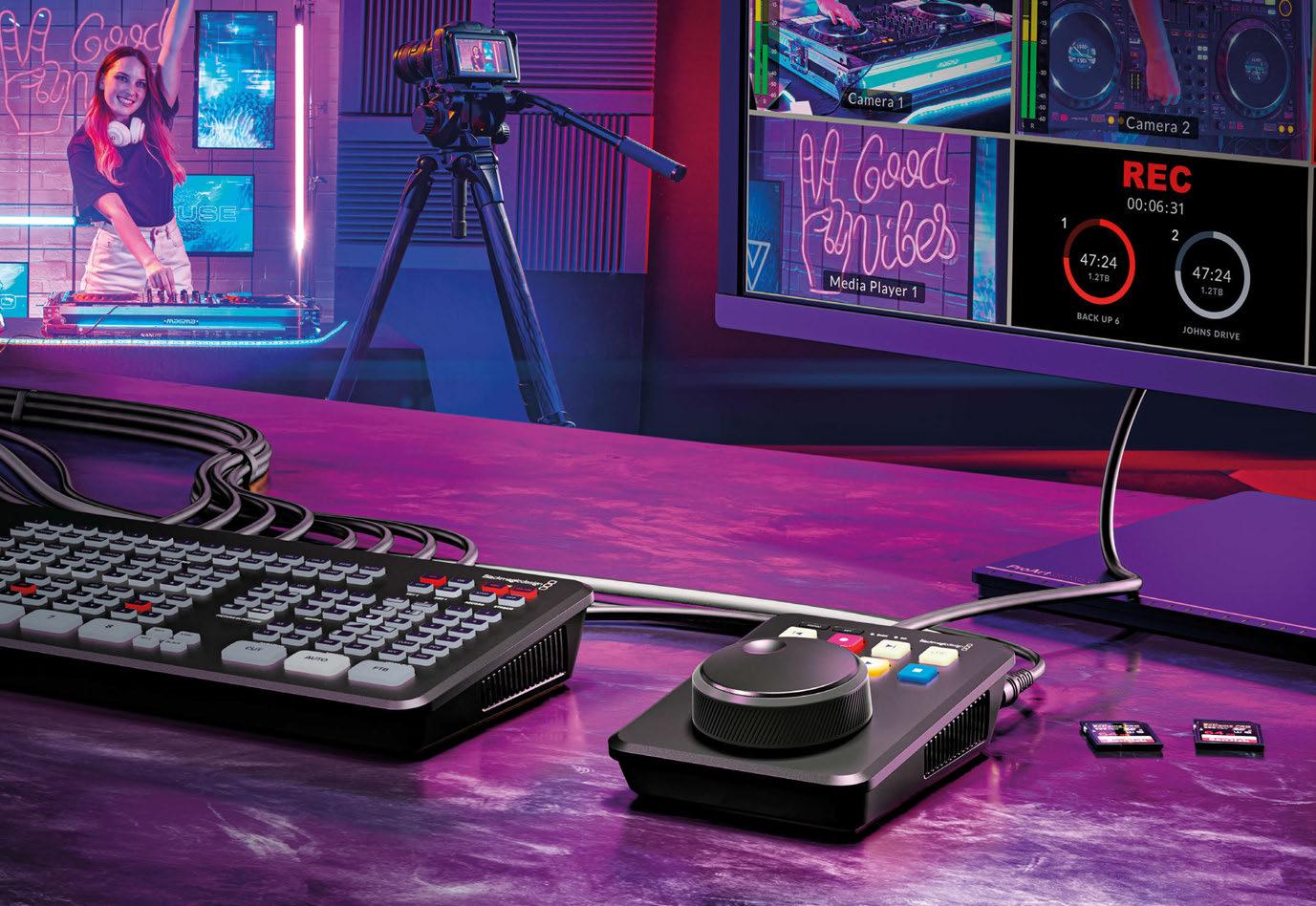
HyperDeck Shuttle HD is perfectly designed for the desktop. This means the front panel can be operated with a single hand! The design is the same depth and angle as ATEM Mini Extreme, so they match perfectly when used together! Scrolling media is fast as the machined metal search dial has a natural inertia, and the soft rubber surface feels nice to the touch.
HyperDeck Shuttle includes a control panel that’s very fast to use. The buttons are similar to a traditional broadcast deck. Simply press the record button and you instantly start recording the video input to a file! It will record in the file format t h at has been set in the record menu. There are other buttons for playback, to cue to the start of the clip and to move to the next clip.
HyperDeck Shuttle supports recording to common SD cards and UHS-II cards so you don’t need expensive custom media. When using H.264, the files are so incredibly small you get very long recordings even on smaller low cost cards. This means you can record up to 157 hours of H.264 in 1080p59.94 on a 1 TB card. That’s over 6 days of recording in HD using a single 1 TB card!
If recording to other types of media is required, the USB- C expansion port lets you plug in an external flash disk for recording. USB-C flash disks have unlimited c apacity because they can be physically larger than an SD card or SSD. Plus, it’s even possible to record to a disk you’ll use for editing, so you don’t need to waste time copying files before starting post production.
rx render nodes powering visuals alongside Lightware UBEX video distribution technology.
Commenting on the use of Movers at Illuminarium, Powersoft US General Manager, Tom Knesel said: “Mover was engineered to provide the best and most realistic immersive experience to users. We are incredibly proud to be providing our patented haptic infrasound technology to help reproduce realistic sensations for visitors in what is set to be the next generation of entertainment venues.”
When Illuminarium began its pursuit for an AV-over-IP video distribution solution, Lightware was top of its list.
“Illuminarium is a total experience that touches all the senses. Lightware’s UBEX video distribution technology makes it possible to create an infinite video landscape that covers every surface of the venue and provides seamless instant switching for ultimate flexibility and reliability,” explained Steve Samson, Vice President of Lightware Visual Engineering. There were several must-have features and qualities that Brian Allen, VP at Illuminarium, was looking for.
“First and foremost, the solution had to be able to handle uncompressed video signals since any loss in quality would have jeopardised the overall visual experience,” Samson explained.


UBEX allows for signal extension at 4K UHD at 60 hertz (4:4:4) using packet-based

transmission. It can simultaneously transmit and receive content with deep-colour streams and multi-channel audio. “UBEX was the clear winner with its uncompressed signal management capabilities,” remarked Samson.
The lack of latency was another important feature. UBEX delivers Zero Frame Latency, which is less than 0.1ms – undetectable for the human eye – which was also crucial to achieve the immersive experience.
“UBEX enabled us to push the boundaries of technology and innovation by delivering truly uncompressed content without any degradation at all in our signal from the camera, playback and projector,” Samson reported. “We decided to integrate UBEX because of the lossless quality, incredible flexibility and reliable video routing it offers.”
Alan Greenberg, CEO of Illuminarium Experiences, concluded: “Through this collective team of best-in-class partners, we are ultimately building a new media model to support Illuminarium’s completely unprecedented experiences and spectacles. This format is so exciting because it creates endless opportunities for content creators and makers who want to push the boundaries of technology and media experiences.” www.illuminarium.com www.holoplot.com www.lightware.com www.powersoft.com

In support of her sixth studio album, Chromatica, Lady Gaga and her production team hit the road with perhaps their most ambitious touring campaign to date. Having paved the way for immersive wearable technology in recent years, PixMob was enlisted by Lady Gaga’s longstanding creative team, spearheaded by Lighting and Production Designer, LeRoy Bennett, to enhance The Chromatica Ball experience.
“We were approached a few months before the start of the tour. Knowing the level of creativity and quality in these shows, we were glad to be part of the conversation,” said PixMob President, Jean-Olivier Dalphond, highlighting PixMob’s involvement in the multimedia spectacle.
“At PixMob, we love amplifying show lighting design by extending it to the crowd. The wristbands are with fans on the floor, so they create a sea of light for all attendees around the
venue. The first moment they light up is always the strongest, the excitement of the crowd still gives us goosebumps.”

Pi xMob wristbands were programmed on a grandMA console and integrated into the main showfile of the show to seamlessly integrate the visual design of the show and immerse the audience of ‘Little Monsters’.
Over 100,000 units were produced for the ambitious run of shows. “We have completely redesigned our wristbands,” Dalphond noted.
“Everyday for the past year we have spent 30 minutes with all of our internal departments, from product, R&D and manufacturing, through to our clients to evaluate and discuss our products and their evolution.”
According to Dalphond, PixMob has developed more sustainable wristbands and reduced plastic consumption by 50% in recent years. “We’ve optimised how they’re assembled, and now offer full branding across
the whole wrist strap for The Chromatica Ball,” he reported.
Having invested time and energy in diversifying its range of products in recent years, Dalphond highlighted the importance of PixMob’s flagship solution.
“We love wearables and we’ll keep at it, we are also proud of our new product family Nova where we can be even more sustainable and do multiple shows (20) without changing batteries, which we increasingly use in set lighting,” he explained. As for shows, PixMob personnel are currently on stadium tours with The Weeknd, Bad Bunny, and Imagine Dragons, to name but a few. “Stadiums are one of our favourite canvases to design shows for and we will continue to do so with the support of amazing and talented artists and production teams,” Dalphond concluded. www.ladygaga.com www.pixmob.com
PixMob President, Jean-Olivier Dalphond reflects on the firm’s involvement in Lady Gaga’s latest ambitious production.Photo: PixMob

TEG Live Europe brings HallyuPopFest to London’s Wembley Arena for its first European live show, entrusting Symphotech Director, Simon Barrington with managing the incoming production, venue, and artist liaison duties.

Spanning two days in Wembley Arena, HallyuPopFest saw 14 different bands performing in a fast-moving visual spectacular, with a generous amount of special effects and high-quality audio, delivering a distinctly different live experience for fans in a format breaking from traditional Western rock or pop concerts.
The two show days consisted of three main elements: a VIP outdoor ‘red carpet’ arrival for 1,400 fans; an artist ‘meet and greet’ for VIP ticket holders; then the evening showcase, featuring up-and-coming artists, followed by the main headline show, which was a continuous concert featuring seven acts, linking the slickly choreographed sets into a three-hour show. In addition, HallyuTown, located 500m from the venue in its own marquee and outdoor space, was a Korean Government-funded economic/cultural experience to promote business links with around 30 Korean SMEs, which included food, beauty and lifestyle products.
“We’ve been working on this for eight months, although conversations began prepandemic with HAH Entertainment, HallyuPop’s Singapore promoters and founders. Alice Tan and Selina Ho have been key people from their side, supported by a very professional team that was critical to this working so well,” said Alex Nash, TEG Live Europe Promoter Representative and Operations Manager for HallyuPopFest. “HAH Entertainment brought an initial design to us and Wonkou Shin, their Show Director, fine-tuned every element of the live show.” Symphotech managed the production for all elements of HallyuPopFest and HallyuTown, liaising with the Korean producers, HAH Entertainment, MBC (Korean national broadcaster), Wembley Arena, Brent Council licensing authority and Wembley Park

landlords, Quintain. According to Symphotech Director, Simon Barrington, transporting HallyuPop’s Singapore formula to the UK was the central challenge.


“If we had simply picked up the format of the show from Singapore, it would not have worked here in Wembley,” he commented. “We had to reorder the programme to start with the outdoor red carpet, previously in the middle of the day, into the showcase event, before the main ‘headline’ performances. There were some marked cultural differences in how they could operate in the UK compared to Singapore and Korea – particularly around making late changes, which required detailed negotiations, mostly through translators.”
With “little to no technical advancing with the artists” the Symphotech team delivered the Korean show design, “going through every detail and making a lot of adjustments in advance”. Barrington explained: “We worked with Alex [Nash], to make sure the stage and screen design allowed for maximum audience capacity in Wembley Arena, accommodating a large FOH with raised cameras at the rear.” Barrington specified the UK suppliers. “Knowing this was going to be a busy festival
and concert season with shortages likely, I contracted suppliers early: Solotech for audio, lights from Colour Sound Experiment, video from 4Wall Entertainment, TAIT for staging, Ataka for local riggers, BPM SFX for special effects and lasers, Eat to The Beat for catering and DNG PEC for local crew. They are all companies I have enjoyed long, strong relationships with, so I not only wanted to make sure we secured them, but it meant budgets were fixed well in advance, which was important for the clients. We also brought in our own CP security and COVID-19 testing teams”.
The Wembley Square Red Carpet Stage was the first time that The Wembley Arena Square has been used for a live performance. Symphotech took the lead on health and safety and site use in discussions with the Wembley Park landlords, Quintain. “There have been red carpet events on the Square before, but this was the first time it’s hosted a stage as well,” Barrington noted. “In Singapore, there is lots of space around the venue to do the outdoor element of the show the clients are used to – that is not the case around Wembley. We brought in a covered stage, but the limited space in the Square meant that we had to dismantle barriers and carpet and secure the stage between the shows to allow for ingress and egress. Evolution Stages and UK Events Group gave us attentive, flexible service and working in that area was a great success.”
Barrington worked with Managing Director, Will Hodgson, who focused on the health and safety aspects of the red-carpet element and


supported him on site throughout the weekend. Also on the job were Symphotech’s Dominic Walker and Jason Quinn, Stage Managers; Mish, Amy, Souren and Grace on artist liaison; and Russell Pate looking after HallyuTown management alongside Scott Leven looking after site safety.

With 14 artists all coming with their own entourage, the logistics were challenging. “We have been through a lot of changes to make the design work in Wembley,” Nash revealed. “Simon has the patience of a saint to take on a lot of updates for 14 artists being channelled through one director. We treat them all as headliners, with full production throughout the show, so it’s been full-on from the moment we started rehearsals. We’ve also run constant COVID-19 testing – something that was thrown into the mix last minute, with it now being a requirement to re-enter South Korea.”
Yet despite the challenges, Nash was very pleased with the results. “The appetite from the fans for bringing K-Pop to the UK was instantly apparent – we had 20,000-plus people register interest for tickets within 24 hours of announcing the dates,” he concluded.
“The pandemic reduced the size of our team, so we refined our processes and infrastructure coming back to make this work. Without bringing in Symphotech, we would not have been able to deliver this show – especially given how detailed the Koreans are with what is a very technically advanced production.” www.hallyupopfest.com www.symphotech.co.uk




Despite the mounting challenges to the global supply chain and workforce shortages in the wake of the pandemic, there’s a mantra within the Red Hot Chili Peppers (RHCP) touring camp of ‘patience, tolerance, understanding and a teacher’s heart’, which TPi is informed of by Production Manager, Narciso ‘Narci’ Martinez six dates into the band’s latest world tour at Emirates Old Trafford.

“T he band are always pushing the envelope, creatively,” Narci began, embarking on his fourth world tour in 12 years with RHCP. “This has been an easy gig to staff because we are offering people three years of work at the tail end of a pandemic. We had a ‘test run’ in the US last year with another client, so we secured our assets and despite a few personnel changes since, we got a good metre on the challenges ahead and were largely able to address them.”
Supporting Narci with the day-to-day operations on the road are Tour Accountant, Timothy Duffy; Tour Accountant Assistant, Gwendolyn MacQueen; Production Coordinators, Heike Kraemer and Luke Bell; Backstage Coordinators, Joanne Conaty and Lyssa Bloom; Backstage Assistant, Cherry May; Venue Security, Armando Vera and Brett Weiss, along with Band Security, Ryan Wheeler
and Andrew Philip. “I have reached up with my support staff for redundancy in case anything happens to me. I don’t micromanage, everyone has their gig to do, and it’s an open-door policy,” he added. “[COVID Compliance Officer] Amanda Ferriter deals with the paperwork associated with COVID-19. As a team, we acquire the data, navigate the regulations, and adhere to the guidelines in each region.”
With five cases in the crew at the time of writing, the pandemic hasn’t slowed down the progress of the tour. “We’re redundant in most departments, so if we’re one person down, we have someone to fill their shoes,” he added.
“We call it a strategy rather than a policy, and it has proven successful thus far.”
When the crew began the tour, a bubble formed around the band, with the crew taking all the usual necessary steps to mitigate the virus. “All of our shows are outdoors, so we don’t enforce the mask rule unless we’re in close quarters,” Narci revealed.
“T he crew take antigen tests every day for five days if someone on the bus tests positive, but we only PCR if there are cases around the band,” he reported, adding that antigen tests are an “insignificant cost” for the value that they bring to proceedings. The tour’s technical
suppliers came in the shape of Xpeditious freighting, Beat The Street buses; Pieter Smit trucks; Clair Global audio; Premier Global Production lighting; Colonel Tom Touring video; Twenty Three set design; Wickley Worldwide supplied staging; Rad Island media servers; Setup Designs content creation; Consumer Recreation Services rigging and motors, as well as The Powershop, Guardian Barrier Services, and Earshot Radios.
Narci acknowledged the additional layers of expense when budgeting a modern-day tour. “The cost of everything is elevated post-pandemic. Everything costs more but we’re also operating on a larger scale, so we’re probably better profitability wise, than we were when we were operating in indoor venues.”
With a lack of clarity on Brexit rules and cabotage, Narci was happy to enlist the support of Pieter Smit to transport the crew’s gear from A to B. “When I was trying to lock in trucking a year ago, there was a lot of ambiguity surrounding UK trucking companies. I’ve had Pieter Smit as a sub hire on prior tours and their Lead Driver, Jasik Jacek, is one of the best I’ve had in my past 27 years of touring.”
Lead Bus Driver, Kevin Watson oversaw a team of four drivers, while Lead Truck Driver,
All events have one common factor, your equipment must be reliable at all times. There’s no stopping the show, whatever happens. That’s why the LED screens from ROE Visual are not only of the best quality they are also very reliable, quick to build and easy to service. Whether an out- or indoor event ROE Visual LED products provide the solution to maximize the visual experience for your audience. www.roevisual.com

Jasik Jacek oversaw a team of 24 drivers. “It was a pleasure to work with this production,” Pieter Smit’s Steven Kroon commented. “The schedule was brutal, but doable. A few double drives were needed. Our drivers were happy during and after the tour – this is always a good indicator for me. Even with the tough schedule, our people had their spirits up. This means that production had everything sorted: parking spaces, catering and even massages were available for touring crew. We are looking forward to working with the RHCP again.”
Head Rigger, Gabriel Wood was joined by Automation Rigger, Jefferey Breisacher and Rigger, Charles Anderson on the road. While the stage and carpentry team was made up of Stage Manager, Guy Habosha and Assistant Stage Manager, Joshua Perree; Electrician, James Evans; Head Carpenter, Jason Spisak; Barricade and Carpenter, Craig Edwards; Carpenters, Justin Johnson, Steven Davidson and Charles Philips.
Affectionately referring to his riggers and carpentry team as his airforce and marines, Narci highlighted the shortage of local labour in each pitstop along the tour. “Although we’re not short on riggers, they’re short on experience given the past two years, so there’s an opportunity for our rigging team to practice patience, tolerance, understanding and a teacher’s heart. We need to build an environment for support staff.
“We’re still finding success among the challenges,” Narci noted, praising his battlehardened crew. “If we all adopt this mentality,
we’ll get the operations side of the business back to where it needs to be. The consumer demand for production value is there, but we need local support staff and infrastructure to support that.”
‘100% LIVE’
With a setlist handwritten each show day by Anthony ‘AK’ Kiedis, the team are kept firmly on their toes. “There are a few consistent songs, but they can be all over the place, so it can be a challenge for the creative team to curate content for up to 45 songs. Above all, this is a band with real music – nothing is on track, it is 100% live,” Narci said, recounting the team’s role of amplifying the band’s energy using cutting-edge production techniques. “Having John Frusciante back has added a refreshing element and definitely elevated proceedings.”
The focal point of the production design was a giant sloping central video screen, dubbed the ‘halfpipe’, ‘the wave’ or the ‘clam’, depending on which member of the crew you spoke to. This structure, constructed using a combination of 968 ROE Visual CB8 full and half tiles, had seven sections – the roof or ‘lip’, a ceiling, an upstage curve, a back wall, floor curve, an LED floor, and a curve down to the ground. This was flanked by IMAG screens made of 160 ROE Visual CB5 9mm LED panels.

Twenty Three designed and manufactured six trailers worth of materials for the central video set, including a ceiling, back wall and video deck, with all elements connected seamlessly by bespoke curved video sections.
“When Narci explained the concept and timeframe, we thought it was impossible. Build up procedure, wind load study, and quick mechanical disconnections are just a few challenges posed with building a structure like this,” Twenty Three CEO, Kristof Soreyn said.
With offices located in China, Belgium and the US, Twenty Three enlisted an international team of highly qualified engineers to come up with a solution. “After a careful evaluation, we divided the project into segments. Our Belgium and China design and manufacturing teams could work around the clock, to turn around six trailers of customised mechanical elements in just two months,” Soreyn stated.
“T he structure is heavy and we have different stages in different regions, as well as festivals, so we can go from an A rig to a B and C rig; the first two are similar bar trim heights, so we lose a row. The LED floor and the ceiling are cut for the festival configuration,” explained Video Crew Chief, Tyler Raphalian, who also operated robo cameras during the set.
“Getting the tiles to line up seamlessly is a challenge,” Raphalian pointed out. “The roof is not like a truss. It needs to be where it’s at, so that poses lots of challenges. The tiles on the floor and ceiling also must be hand slid into place, so everything is cabled up each day, like a permanent install. The support of Major Tom is invaluable on the road. Anything you need, they have solutions for. I can talk directly to the owner without several degrees of separation.”
Video Director, George Elizondo walked TPi through his creative process. “We have come
out hard, straight into stadiums,” he began. “There are a lot of new songs on the setlists, and the fact that Frusciante is back means there is huge contingency on stage. Each four personalities get equal airtime, which is my primary goal. The band’s performance varies each night, so it keeps me on my toes.”

Elizondo explained his approach to artistic visual narration. “With shooting in stadiums, we must be conscious of ensuring everyone can see what is happening on stage, blended with a level of artistry as opposed to just capturing them in a static way. Some of my favourite looks are the intimate relationship shots between Flea and John when they jam together. I go between tights of what they’re doing and then to a two shot to document the emotion of their faces. From where I’m sitting every night, it appears the group is back to its best and they’re having a blast on stage.”
Video Engineer, Shane Watson handled CCUing the iris levels of three handheld cameras, four robo cameras and three POV cameras. “I built this Ross Video-based 4K system 10 days before rehearsals, due to supply chain issues,” he remarked. The video feed travelled to media servers, located in FOH, via 12 lines of MPT12 fibre cable – spanning approximately 500ft in length where video content could be manipulated by Resolume and

TouchDesigner media servers on an MA Lighting grandMA3 by VJ, Joshua Upton.
Technology Integrator, Laith Dixon of Rad Island oversaw programming lighting and video on the tour in coordination with several people in the visual team and managed FOH technology, lighting consoles, media servers, and an ‘intensive’ networking system.
“Half of my role is to be creative, the other is to make sure everything works,” said Dixon who, in conjunction with Colonel Tom, provided his personally owned media servers and FOH infrastructure. “On some tours I programme everything, and on some I programme just lights or video and the creative team headed up by Scott Holhaus or department heads will programme,” he explained. “It depends on where we think the needs are, what we want the show to look like and who’s skills best align to maximise our collective efficiency.”
On t his tour, Dixon controlled the media servers, while the creative work was achieved by other members of the camp. The backbone of creative content is achieved within discreet TouchDesigner and Resolume media servers, which the team bounced back and forth from during the show. “Our principal content is produced by Setup Designs, who create the
majority of content, effects and generative looks from using TouchDesigner,” he noted.
“Everything is generated live. We recall those scenes and Josh drives parameters like shape, swell, and growth of the visuals by using an MA Lighting grandMA3 console run in MA2 mode.”
The creative team experimented with varying looks and techniques in rehearsals based on the back catalogue of the band.
“Chasing IMAG ISOs with the band on the screen is something we’re portraying on this rig. It’s been cool, challenging, and beautiful to experiment with this. We sometimes see members of the band turn around and look at the wall and look equally perplexed and pleased,” Upton said.

Generated and manipulated content brought a ‘new school’ feeling to RHCP’s trademark IMAG-heavy live looks. “The content is playful, so as we progress over the next two years, the looks will develop, evolve, and take on a life of their own. No two shows are alike,” Upton stated.


“We play content to the music as soon as the setlists come through, and flow in different directions. Sometimes we get to play around with songs. One of my favourite looks is Give It Away, which is a portrait design with different
shapes and realms. By The Way ’s stained-glass aesthetic is an equally big and powerful look.”
Video content was bitmapped to align with the lights on the centre screen, as an extension of ‘the clam’, to create a 3D visual experience. “The entire visual rig is backwards compatible. It’s an energetic show, so we need to keep pace with that,” Upton reported.
“W ith the technology age that we’re in, defining that middle point between live and digital consumption, like social media, is what we strive for. We’re all trying to figure out that middle ground.”
The video team was made up of Video Director, George Elizondo; Video Crew Chief, Tyler Raphalian; Video Engineer, Shane Watson; VJ, Joshua Upton; Lead LED Technician, Keith Blackard; Video, Carp and LED Technician, Jordon Wyment; Camera Operators and LED Technicians, Jeff Apregan, Stephan Peters, Christopher Small, and Michael Wilson.
Technology Integrator, Leif Dixon; Lighting Designer, Scott Holthaus; Lighting Crew Chief, Peter Schofield; Lighting Technicians, Kurt Crosley, Kenneth Lansden, Colt Hester, and Matthias Vollrath; Dimmer Technician, Timothy Gallup; Lighting Technician and Robospot Operator, Amanda Ritchie, also featured.










“We started with a Yamaha RIVAGE PM5, a RIVAGE PM3 for broadcast, and two DiGiCo SD7s on stage. Once we started with rehearsals, the band made it apparent that they would rather have analogue consoles, if possible. John Frusciante in particular is a very strong proponent of analogue sound and asked us to explore some options,” FOH Engineer, Toby Francis recalled.
With the channel count, 50-plus inputs and effects returns required for the show, Francis and FOH Technician, Andrew Kastrinelis – who’s charge was integrating analogue and digital workflows – specified Rupert Neve Designs RMP-D8 preamps on stage, which was shared between FOH and Broadcast Mixer, Bo Bodnar on a Dante split.
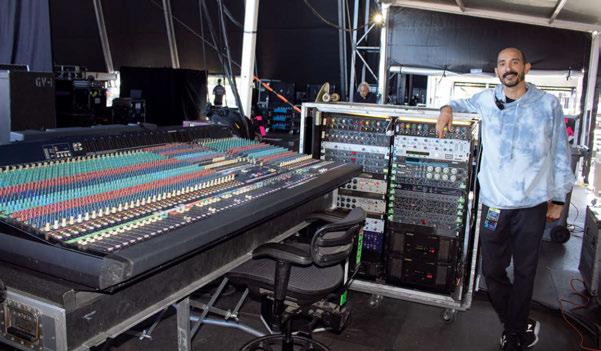
“We looked at cable length, as some of the shows are 500ft away from the preamps. There was no way to deliver an analogue snake that long and it would sound horrible anyway, so we started experimenting with different ways of doing it,” Francis said.
“We converted the preamps to Dante, while it’s in the Dante realm, we split it in different ways for virtual sound check, while RedNet switches convert it back to analogue to experiment with the level.” While in the Dante
realm, Francis interjected UAD servers to the drum channels to create effects.
“I have two AMS levers, one hardware unit and the other virtual. After looking at a series of consoles, we decided on a Yamaha PM5000. It is a great-sounding desk. All the faders, mutes, and sends can be automated. I also use a StreamDeck because managing snapshots on a 20-year-old computer isn’t always easy,” Francis explained. “RHCP are a rock, pop, funk, reggae, jam, jazz, fusion and progressive band all-in-one, and we never know what direction they might take with their delivery, so I required a desk that can go from song to song quickly, and handle dynamic changes across the console,” he noted.
FOH Technician, Andrew Kastrinelis helped maintain the upkeep of the analogue gear on the road. “It’s a remarkably heavy setup; we’re clocking in at over 900lb at FOH with just the console. The support of Clair has been excellent, particularly Tim Omel in the US,” he said, praising the tour’s audio vendor.
“Equally, having the Los Angeles shop 30 minutes from rehearsals made it very convenient for us. We were afforded the freedom to trial some analogue gear and ‘torture test’ some of wares to figure out their flaws, learn the warnings and see the signs
 The Video Crew; FOH Technician, Andrew Kastrinelis and FOH Engineer, Toby Francis; Monitor Engineer, Matthew Andrade.
The Video Crew; FOH Technician, Andrew Kastrinelis and FOH Engineer, Toby Francis; Monitor Engineer, Matthew Andrade.

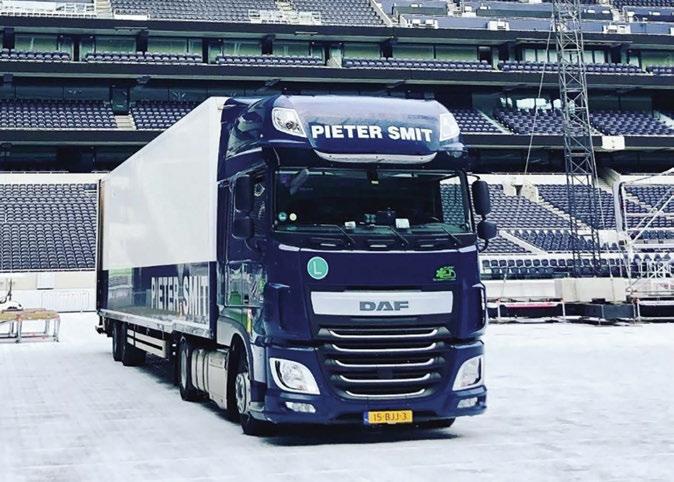




before we hit the road. I don’t know another company that can send you three Massenburg DesignWorks EQs overnight and have them the next day. No matter what we asked for, we had them the next day.”
The PA of choice was a d&b audiotechnik GSL system, with J-Series delays in Europe and KSL Stateside. “We purchased this for the tour due to the rear rejection – the band doesn’t want to hear or feel the PA on the stage. We tested all the PAs and configurations and this came out on top. This is the first PA I’ve chosen solely by standing behind it. We were amazed at the rejection, and after using it, the coverage and how the ArrayProcessing works is perfect for this application. We’re playing stadiums, which are arguably the worst acoustic environments possible, so any extra clarity is huge for this type of tour,” Francis enthused.
“The sheer amount of power the PA has behind it is impressive. When you hear the drums rattle through the PA, it hits you right in the chest and you can feel it,” Kastrinelis added.
“This band has a shit tonne of great songs and they change the setlist from night to night. Certain songs strike chords with the audience more than others, but this band jams. It’s a truly unique music performance, which master musicians will put on, all vibe and feel – each show is different,” Francis added. “We’re still looking to enhance this setup with more outboard gear for improved tonality. Matthew Andrade, Monitor Engineer for John Fruscinate
and Flea, mixed on a Yamaha PM1000 console. While fellow Monitor Engineer, Vish Wadi mixed the rest of the band’s JH Audio 16 Version 2s in-ear mix on a DiGiCo SD7 console.
“I ’ve been a big fan of this band since the Nineties, so it has been a dream gig to walk into,” Andrade began. “I had to adapt to using an analogue console after spending the past decade on digital consoles, where everything is easily accessible at your fingertips. However, I learned my craft on analogue consoles, so it’s been nice to return to it. With analogue, your remit for automation is limited, so you need to approach it differently and more creatively. It certainly has a much ‘warmer’ sound than digital consoles.”
Audix OM7 microphones have been the band’s choice for the past 30 years. Andrade updated the band’s pre-existing rack of outboard gear to get the mix to a place he was happy with, and the quality he and the band of analogue enthusiasts strived for.

“There were some mental barriers I had to break through because I was so attuned to the digital workflow but keeping the mix simple and minimalistic has proved successful. The challenge has been to develop a mix that isn’t too loud for the band on stage with amplification behind them, so while John’s guitar sits a little lower in my ears, it’s a good balance for them on stage, with that added realworld amplification of on-stage instruments.”
The audio team comprised FOH Engineer, Toby
Francis; FOH Technician, Andrew Kastrinelis; Monitor Engineers, Vish Wadi and Matthew Andrade; Monitor Technician, Takayuki Nakai; Broadcast Engineer, Ethan Mates; Systems Engineer, Ville Kauhanen; SR Fly, Thiago Henrique Costa Borges; SL Fly, Gregory Philip Vierley II; Delays, Patrick Anthony Saint John; Mix Engineer, Bo Bodnar and Audio Technician, Justin Smith. Backline Crew Chief, Philip Dannemann; Drum Technician, Christopher Warren; Guitar Technician, Henry Trejo; Bass Technician, Tracy Robar.
Recalling the joy of being back on the road, mixing some of his biggest shows to date, Andrade beamed with enthusiasm: “It’s been a pleasure to watch and mix an ever-changing setlist of older stuff that is so raw, grimey and punk rock through to the melodic, musical and dynamic tracks,” Andrade said, going on to praise the support of Clair.
“My first tour was with Clair in 2011, fastforward a decade and I’m mixing with one of my favourite bands.” www.redhotchilipeppers.com www.xpeditiousunlimited.com www.beatthestreet.net www.pietersmit.com www.clairglobal.com www.premierglobalproduction.com www.coloneltomtouring.com www.setup.design www.thepowershop.eu www.guardianbarrierservices.com

As the gates at Worthy



With 200,000-plus ticket holders waiting patiently for three years since the last time Worthy Farm hosted its legendary festival, it’s fair to say that Glastonbury 2022 was the most hotly anticipated event of the year. Although we’ve seen several large events return since the easing of regulations globally, a mass gathering of this scale was a sight to behold, and something that was commented on by almost every artist who took to the stages on each of the 31 performance areas.

As w ith every festival in Glastonbury’s 50year history, in the months leading up to the famed event, there was a dedicated team of specialists who transformed this working farm into an epicentre of art and culture.

So, with a bag full of clothing for every weather eventuality, TPi left the Hospitality Campsite and commenced a traditional tour of the site to catch up with some of those who made this year’s event a possibility.
With the masses returning to Worthy Farm, it seemed from the outside looking in that the entertainment world was back to normal. Alas, this was far from the truth. With many tours being pushed back into the summer, an abundance of stadium runs and other festivals cropping up – resulting in shortages in both crew and equipment – the strain on the events industry has never been greater. That said, the majority of crew TPi encountered on site were upbeat and shared the same ‘it’s good to be back’ mentality.
Emma Reynolds-Taylor was once again at the top of the production food chain for the Pyramid, Other Stage, and Interstage. With the eyes of the world on the headline performances from Billie Eilish, Paul McCartney and Kendrick Lamar, the pressure was on, and with numerous new faces in the core production team, Reynolds-Taylor had to be on
top of her game.
“I probably only had half of my regular team available, with some moving into the TV world over lockdown and others being engaged in touring commitments,” she revealed. Finding and maintaining a core crew was an ever-evolving jigsaw, with Reynolds-Taylor constantly having to find solutions at short notice – in some cases, days before the festival. “Our regular Stage Manager for the Pyramid is working with Adele; we knew of the conflicting dates back in March when she had to cancel her Las Vegas performance, but then we even had our Pyramid Overnight Stage Manager test positive for COVID-19 on the Tuesday of Glastonbury and had to find a replacement immediately.”
This, of course, led to stressful build-up. “It was a constant evolution from minute one of planning until we delivered the show,” stated the Production Manager, clearly relieved that all the pieces fell into place.
“One thing that certainly worked in our favour was that we saw most of the bad weather before the festival and although there were some horrendous days during the build, the fact we had great weather during the weekend put a smile on everyone’s face.”
This year represented the first time Reynolds-Taylor ran the Pyramid, Other and Interstage areas on her own, rather than jointly, as was the case in the 2020 planning phase, prior to the event having to cancel due to the COVID-19 pandemic.
“I have to give huge credit to our team of core suppliers and their knowledge of the site. Thanks to that we were able to carry so much more information from previous years,” stated the PM, as she talked through some of the changes that were made backstage to create a smoother operation.
“T his goes all the way to the staging, tents, and power supply teams, who don’t always get the credit they deserve. Thanks to them, we found a way of making the dressing rooms wider and longer which was a complex process as they are directly next to the Pyramid stage
and we had to negotiate around the Pyramid itself which is a permanent structure and a hedgerow, without encroaching into the Arena space, while also making the IMAG screens wider this year too. It was very close but we managed to figure out solutions between us all to make both increases a reality,” she recalled. “I think some of the tour suppliers that come in often forget that Glastonbury is a working farm for the rest of the year,” Reynolds-Taylor chuckled. “They talk about Glastonbury as if it’s the world’s biggest venue, when in fact it’s a site where we are always having to work around the farming schedules factoring in grass cuttings and making sure we are creating the least possible impact to the working, familyowned farmland.”
Despite the challenges, Reynolds-Taylor’s overarching feeling was happiness that Glastonbury was happening again. “There is no doubt that life is hard in the live events industry right now, but if people think back to how they felt two years ago, this is immeasurably better.”


The two largest performance stages, The Pyramid and Other Stage welcomed back several familiar suppliers. At the Pyramid Stage, RG Jones returned to handle audio, Creative Technology for video and Neg Earth Lights for lighting and rigging. Meanwhile on the Other Stage, Neg also handled lighting, audio was provided by Skan PA , while 4Wall Entertainment took care of the video delivery.
TPi’s first port of call was with Neg’s Gavin Maze. Working in tandem with Damien Jackson across The Pyramid and Other Stage, Maze discussed what it was like to be back on the farm. “There were a few ‘how do we do this again,’ moments this year,” he laughed as he greeted TPi at Other Stage’s FOH before Nigerian sensation Burna Boy took to the stage. “As soon as we started, the muscle memory soon returned. Being on-site and seeing these headline performances and the crowd’s reaction has been special. It’s also fantastic to catch up with people from the industry we haven’t seen for years.”
Just as in previous years, Neg’s process of


designing the rigs for both stages began with the headliners.
“We have discussions with the headline productions as soon as we can,” stated Maze. “The ethos of Glastonbury is to accommodate artists’ requests as much as possible, this year for example, that meant a major overnight change on the Pyramid Stage of most elements of the Billie Eilish rig to fulfil the design for Sir Paul McCartney.”
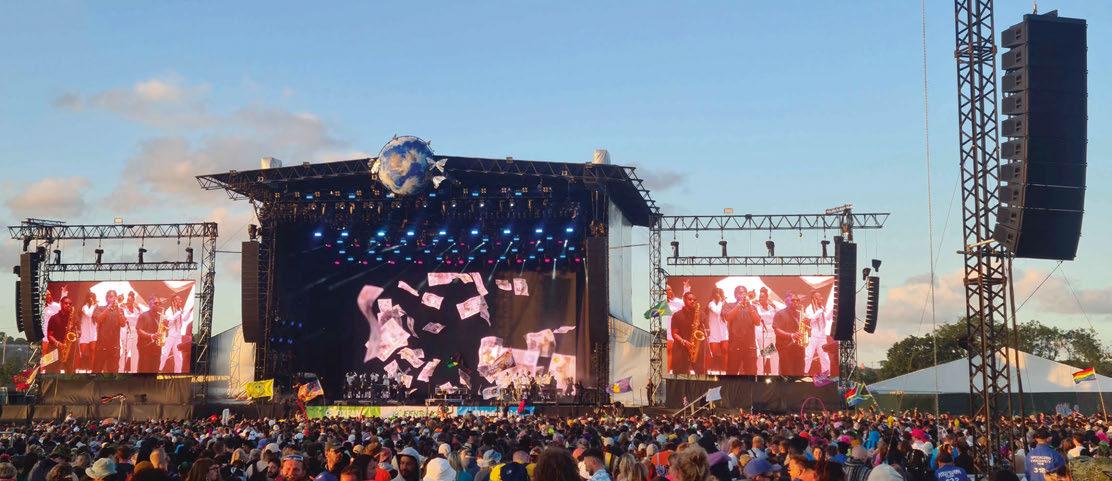
One issue that could not be ignored throughout the weekend was the current issues of stock. However, according to Maze, thanks to Neg’s large and varied inventory, the industry shortage was not much of a hindrance.
“We also have great relationships with various industry suppliers and the global exposure Glastonbury provides gives us an opportunity to give some new fixtures a test run. For example, this year we’ve made good use of SGM Q8 fixtures.”
A notable change to this year’s visual offering on both the Pyramid and the Other Stage was the size of the IMAG screens. The overall effect meant that the audience could be even more engulfed in the live experience on stage, no matter where in the field they were.
Talk ing through the Pyramid Stage was
Creative Technology Project Manager, Gerry Francke. “We’ve gone from a 12m by 9m screen to a 16m by 9m and it’s almost 4K in terms of resolution,” stated Francke, proudly. As well as the bigger screen, this year the production worked much more closely with the BBC.
“We are now much more integrated as departments and there have been far more meetings in the lead up to the festival this year,” he said.
One of Francke’s main roles is to facilitate this closer relationship and he pointed to Billie Eilish’s headline set on Friday as a prime example. “I had the live coverage of the show on my laptop while it was going on and it looked just as amazing on screen as it did out in the field,” he recalled.
ROE Visual Black Quartz 4.6mm was chosen for the IMAGs, while the on-stage screen was made of INFiLED R4.6. “Initially, the same product was to be used across the stage, but with the way equipment has been moving around and with how busy the industry is, the most important thing was to get together a package that works,” he reflected.
Francke went on to explain how this year’s movement of equipment from festival to festival almost felt like a tour. “We’ve also been
short on crew this summer, although that hasn’t been as big an issue on Glastonbury as we had most people booked since 2019 and just kept rolling them over. We’ve got a really solid team for this festival and I’m really proud of what we’ve created.”

Also on site and overseeing Creative Technology’s delivery at the John Peel stage was Graham Miller, Head of Music and Entertainment. “Across all our sites, we wanted to pick up from where we left in 2019,” he stated. “That said, technology has moved on over the past three years, so we’ve tried to implement some of that in our delivery –especially in regard to the back end of the video packages.”
St aying on video, at the Other Stage, TPi caught up with Rhodri Shaw of 4Wall. Having been involved with the Other Stage for several years – albeit underneath the previous moniker of Transition Video – Shaw walked TPi through the changes for this year. “We are providing the outside broadcast facility and cameras for the first time this year as well as increasing the size of screens,” he explained. “We’ve got almost double the amount of LEDs this year, so it has grown dramatically.” 4Wall used its own stock of ROE Visual CB5 and frames for the IMAG


screens. “It’s pretty much a new screen so it’s been good to give it a true field test,” enthused Shaw who was pleased to announce the screens had survived everything from rain and wind through to intense sunshine.
Most of the same crew from the old Transition team were back again on the Other Stage this time round. Like most suppliers, Shaw was pulling off quite the juggling act for 2022 with numerous tours out on the road while also ensuring that Glastonbury went off without a hitch.

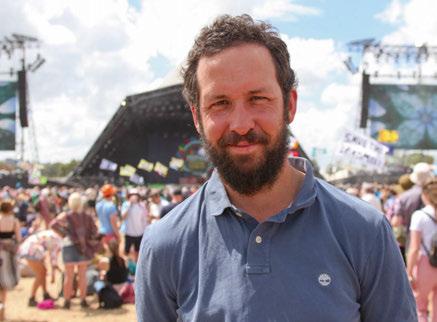

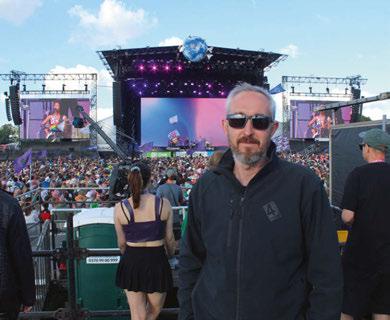


“We’ve got around eight tours out at the moment. We’re getting there but I must admit I’m not sure how sustainable it is in the long term. The amount of work that is simply having to be turned down is crazy but all we can do is deliver on all the jobs that we’ve promised.” It wasn’t just the size of the screens that saw a dramatic increase at the Other Stage but the audio delivery with the second stage getting a full delay system, meaning more people could
enjoy the performance from further back in the field. Skan PA again manned the stage, and TPi caught up with Skan’s Tom Tunney for a quick chat on the famed leather couch at FOH.

“T here has always been this shaded area when people come in from the side, so the delay towers have enabled us to address this issue,” he explained.
The PA in question was d&b audiotechnik system comprising GSL mains with GSL side hangs and SL SUBS in the pit along with Y10s across the subs. There was a centre hang of V series to fill in the first 10m not to mention a brand new out hang set up to cover the shaded areas off to the side where people usually enter the field also made up of V Series. Skan also deployed a new delay setup this time around, made up of KSL boxes. “Matt Vickers Skan’s Senior System Designer and Project Manager, designed the system then came in to start hanging boxes the Tuesday before the festival. d&b array processing on all the hangs
Creative Technology’s Gerry Francke; 4Wall’s Rhodri Shaw; Audio System Designer, Simon Honywill with RG Jones’ Sam Millen and Sarah Gellas; Serious Stages’ Simon Fursman; Neg Earth Lights’ Gavin Maze; Skan PA’s Alvin Russ and Tom Tunney.

enabled Matt to get the maximum SPL in the right places while not affecting our off site contributions,” he explained.
“T he horizontal pattern control of the GSL is so accurate that we cannot rely on wide ‘spill’ from the side hangs as with older systems, so the Vs are perfect to extend the audio offstage and give the full 180 ° coverage desired for the wider audience as they enter our field,” commented Vickers.
“On the whole, the mission was to keep everything as flat as possible so each touring production can have as blank a canvas as possible,” concluded Tunney.
Serious Stages was once again entrusted to look after several performance areas including The Pyramid, The Other Stage, West Holts, The Park Stage, Ribbon Tower, John Peel, Sonic Stage, BBC Introducing, and Left Field – not to mention numerous peripheral structures such as delay towers, VIP areas along with BBC Media Platforms. Simon Fursman, Project Manager, spared a few minutes from his busy schedule to talk TPi through the delivery. “There hasn’t been a great deal of change in what the production wanted this year,” he began. “That said, the festival has upped
its offering when it comes to some of the hospitality areas. As for the show production, the biggest change was the delay towers at the Other Stage and West Holts with an increased number at The Pyramid.”
The West Holts stage was a bigger stage increasing from 19m to 22m Supanova. Another development for Serious was that there were overnight changeovers every night on Pyramid configuration to accommodate the headliners’ sets.
Serious was one of the first suppliers to come on site months before a light was rigged or a PA was hung. Fursman divulged how in the months leading up to the show, the skeleton of Glastonbury is formed. “Along with us, Aggreko and the under-track team also came in relatively early. We deploy two teams that build everything,” he said.
Due to equipment being used on other events, the build of Glastonbury comes together in phases. “We might build 70% of a roof system but have to hold on to the peripheral elements until they are freed up from other shows,” he revealed. While talking about other shows going on in the summer, Fursman outlined how the company had refocused its efforts to corner the large-scale events market.

“We’ve made the decision not to work on so
many smaller festivals this year and instead focus on events such as Glastonbury, Download, and Reading and Leeds along with one off events such Liam Gallagher’s concerts at Knebworth,” he commented. “There are plenty of staging companies out there to cater for those smaller events whereas there are not as many competitors working on these larger shows like us.”
While popping our heads in and out of the various FOH tents on some of the major stages we got a chance to speak to several crew and supply companies who were rolling up with specific acts.

One such meet up was at the Other Stage with Dan Hill and Chris ‘Squib’ Swain from Cassius Creative. The duo were Production and Lighting Designers for Foal’s headline show alongside Lighting Director, Marc Thornton from Full Production. “We were here in 2019 during a secret set on the Park Stage and I think it was one of the biggest crowds that stage has ever had,” stated Thornton, clearly happy to be back on the site and getting to work on the larger Other Stage.
“The show itself looks quite minimal at a glance,” stated Hill, explaining that the real







impact came from the video headers that they had brought in especially for the show. “It’s so slick with the video. Even more impressive is that we have no timecode with Marc running all the cues from his desk through a disguise server setup.”
Uni versal Pixels was also on hand to provide the festival look for Foals, along with its other touring clients, Lorde and Pet Shop Boys. Between the three acts, UP made use of its Leyard LED panels, Resolume media servers, and Kinesys motion control.
UP ’s inventory provided the perfect canvas for the Foals, turning the Other Stage into a neon-drenched disco for My Number and providing otherworldly cloudscapes for Spanish Sahara
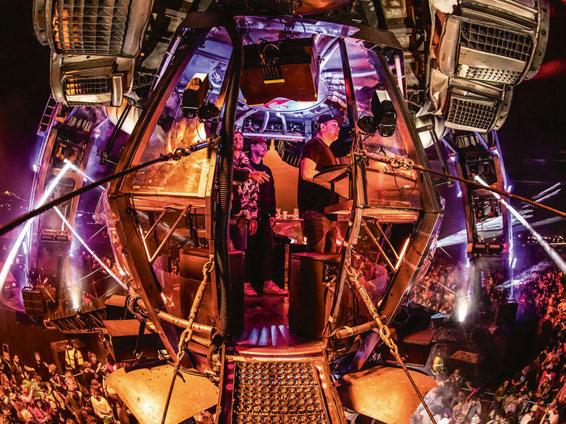
The staging for Lorde’s Pyramid Stage set was a sharp contrast to Foals’ arresting visuals, with a production design taking the audience’s gaze toward the projected upstage sun and rotating sundial, the latter of which doubled as a huge staircase. UP provided a three-camera PPU, as well as all media servers and three crew members led by Rob Fender.
The Other Stage’s Sunday night headliner, Pet Shop Boys, employed Leyard CLM10 panels to create a moving, mid-stage transparent screen, while Leyard CLM6 LED was arranged into 16 rotating totems. All of this equipment, and the PixelBricks used for Pet Shop Boys’ co-founder Chris Lowe’s custom console front was provided by UP. “It was great to be able to support our touring clients at
Glastonbury after these tough years for the industry,” said UP Director, Phil Mercer. “Each artist’s show looked very different and it was a pleasure to support them.”

While scanning the skyline of Glastonbury after dark, our eyes were drawn to the frequent pyro blasts emanating from Arcadia and illuminating the night sky. Much to the pleasure of many Glastonbury regulars, this year welcomed back the beloved Spider, which had not been on the site since 2017.
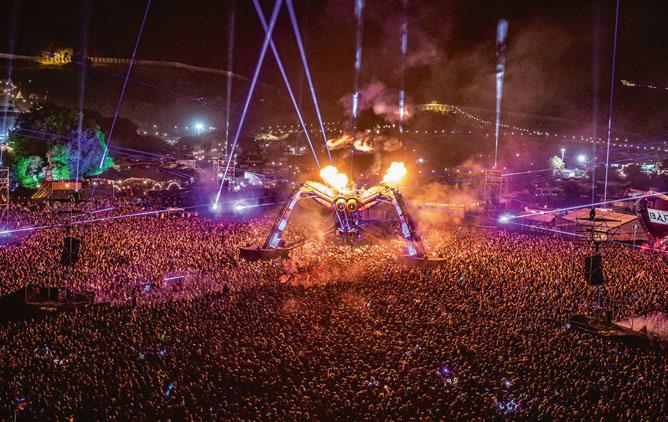
Greeting TPi underneath the giant arachnid was Cyrus Bozorgmehr, Head of Creative Communications for Arcadia, who explained why the team opted to bring back the famed mechanical creature.
“In 2019, we introduced Pangea – which was centred around a large, repurposed sea crane [see TPi #240]. That was year one of a five-year plan, but after three hard years for the events industry, the scale and ambition of what we wanted to achieve was suddenly unrealistic,” he stated. “So, when we started planning for this year, we opted to go in a different direction and bring back the Spider. It felt like a homecoming to have it back and the response from the crowd has been incredible – it really is beloved by the audience.”
The team opted to scale back from the Metamorphosis production for the Spider that had been touring the world prior to the pandemic. “We just wanted this to just be a
party year,” stated Bozorgmehr. “We’ve created a simplified version of the Spider and in doing so have made a more feasible version to tour in the future.”
Walking through some more of the technical aspects of this year’s delivery was Head of Lighting, Katie Davies and newcomer to the team, Technical Production Manager, Simon MacColl.
“A lthough this is my first time working for Arcadia directly, I’ve collaborated with Katie many times before, specifically at Green Man Festival,” said MacColl, adding that it was Davies who gave him the nudge to get involved this year.
“It’s not too dissimilar from other projects I’ve worked on in the past, although I’ve never worked on a spider that breathes fire,” he laughed, as the pyro team fired a few test blasts prior to the evening’s festivities.
Although the production was scaled back somewhat, there were still a few new elements. “Lasers were the big thing for us this year,” enthused Davies, describing the package provided by Reach Lasers
“Previously, we had only used lasers rigged underneath the Spider shooting upwards, whereas this time, we have them rigged on the surrounding PA towers. This means we can create a ‘spider web’ of laser beams, which we’ve never been able to do before.” This year’s lighting was designed by Dave Cohen from MIRRAD, and co-ordinated by Davies. Arcadia previously owned a selection of the
lights, however they were sold during 2020/21. “This has really worked to our advantage as it meant we had our pick of brand-new equipment,” stated Davies.
“When we designed t he first shows w ith t he Spider t here were not nearly as many IP-rated fi xtures, w hich meant we had to devise waterproofing solutions.”
However, w ith t he proliferation of IP-rated fi xtures, t he LD had several options, which saw the incorporation of the Ayrton Perseo Profile for t he eyes of t he creature.
Another change the team made from the original rig was trading the strobes for SGM Q8s w hile changing t he original Robe BMFLS to Robe iPointe65.
“We’re incredibly lucky to have the support of companies such as Robe which has provided us with new demo stock,” stated Davies.
Also aiding t he v isual aesthetic of t he A rcadia was CEG in collaboration with Enlightened, along with Festival Gas, which provided t he bio LPG for t he pyrotechnics, and A ir Products for the helium in t he inflatable balloon t hat was used to elevate an aerial ar tist during the show.
“Both f uel for t he pyro and helium were incredibly hard to come by w hen we were preparing for t his performance, so hats off to both those suppliers,” stated Bozorgmehr. AF Live was also on board to provide t he surrounding L-Acoustics system for t he site.



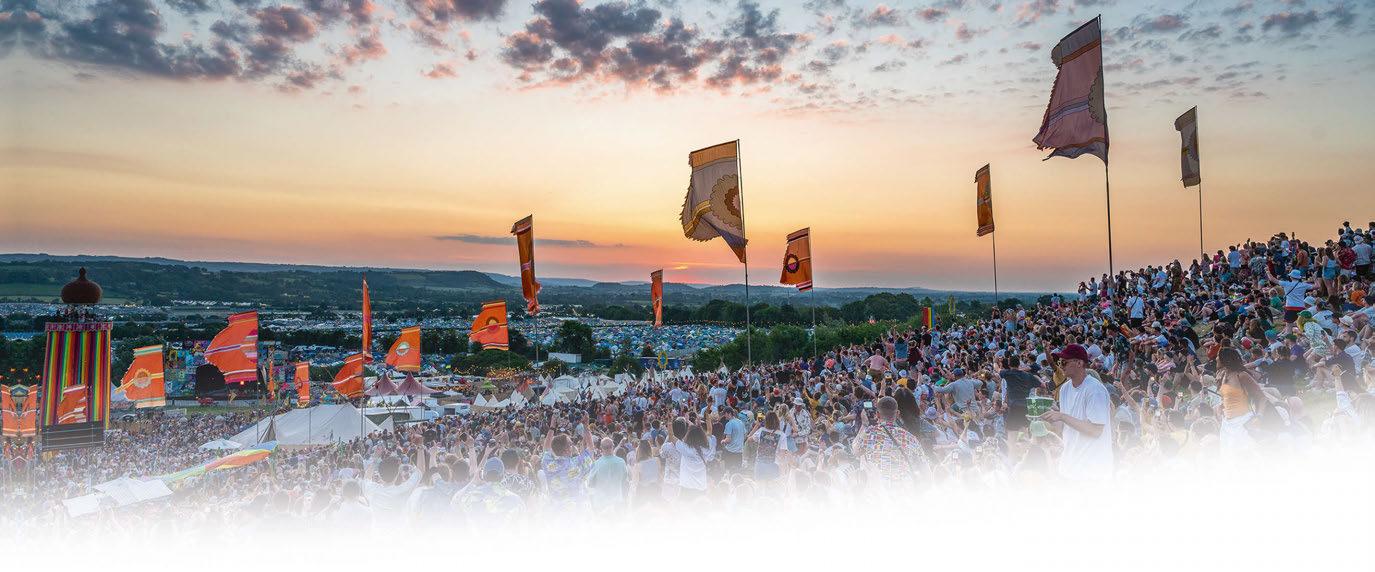
GMC Events started working with Arcadia as site consultants eight years ago and for t he past six years Site Manager, R yan Wilmot has worked on every show w ith t he Spider across t he globe. “GMC now delivers all A rcadia shows internationally,” began W ilmot.
“T here’s a reset and relaunch kind of moment after the pandemic and we’re stepping back into the international market with a new streamlined approach. “We’re creating a new A rcadia experience w here we’ve stripped back the show as we start the evolutionary cycle again. It opens new and exciting creative doors and opportunities.”
Just behind Arcadia, the Park area hosted some of the most anticipated sets with the likes of Wet Leg drawing huge crowds. Once again holding down fort was SWG Events , which looked after the audio, lighting, and video package. Mark Bott walked TPi through the company’s journey to Glastonbury. “It’s fantastic to have the family back together,” he began. “There is nowhere else like Glastonbury.”
As well as handling the audio, lighting and video on the Park Stage, the company also provided sound and lighting on several other venues within the Park site such as the Rabbit Hole. SWG also provided sound and lighting for Left Field, BBC Introducing along with audio for the John Peel stage.


In t he past year, the company invested in some new equipment, which was given its debut at Glastonbury. “This year, we are using Martin Audio. We’ve recently invested


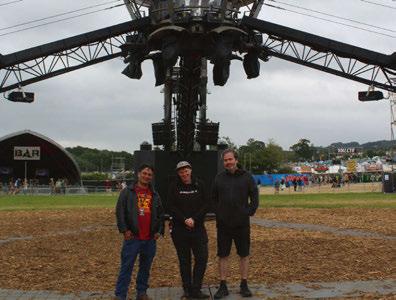

in Martin’s WPL Large Format Optimised Line Array, which was out on this year’s Pyramid Stage as soon as we took delivery,” stated Bott. “We’ve also had great manufacturer support from companies such as Robe lighting.”
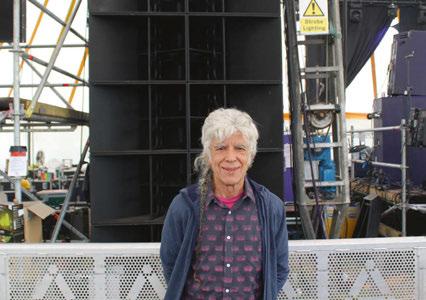
A stone’s throw from the Park stage, TPi caught up with the team at Funktion-One who this year had moved out from its usual stage in the trees. The popularity of the Glade in recent years saw a re-organisation of the area to accommodate a much bigger Glade Stage. While the new tent was acoustically challenging, Funktion-One’s Vero still impressed. The flown Vero system featured two V90s, three V60s and three V315s per side, plus Evo 7Ts for front fill and out fill, and a delay stack of three F221s and two Evo 7Ts.
Funktion-One split the bass into mono blocks of 12 F124 with five F221 gradient cardioid stage right and five F221 with one F221 end fire stage left. Amplification for the main system came from Lab.gruppen
PLM20K44s, apart from the F124s which were powered by two Powersoft X4Ls, with two Lake LM44s chosen for system control – taking digital with analogue backup from the DiGiCo SD12s with SD Rack loaded with Stadius preamps at FOH. Funktion-One and rental partner Audio Plus devised a bespoke system to take digital signal from the Pioneer DJ mixers straight into a separate Dante network and into the FOH console, maintaining 96kHz digital signal path all the way to the amps.
In addition to his technical duties, FunktionOne Founder Tony Andrews played a set before Carl Cox and Eric Powell took to the stage on Saturday afternoon. “There were some real standout moments,” he said. “Marshall Jefferson was great, as were Carl and Eric. Camelphat’s bass drops in combination with the mono block of F124s has to be amongst the most impactful bass I have experienced.”
Keeping to the dance theme, on the way back to the Pyramid Stage, TPi checked in with Nick Whiteoak of Video Illusions, who was once again manning the video delivery of the Silver Hayes area – although that was not all. “We’re doing a lot more than we’ve done in previous years,” enthused Whiteoak, who listed off Video Illusions’ responsibilities, which included Silver Hayes, The Lonely Hearts Stage, The Green
Peace Stage, projection in Village Green and finally the Gas Tower in Shangri-La.
“It’s a different world down there,” chuckled Whiteoak, while discussing the latter on the long list. “That said, it’s a world we’re very used to Robin Collins, who we’ve worked with on Boomtown for a long time, brought us in and we jumped at the opportunity as it’s a very creative part of the site,” Whiteoak said.
He went on to discuss the issues facing the team this year with so much going on in the live event outside of Glastonbury. “It’s been incredibly difficult keeping on top of everything. However, the opening of our Glasgow base has helped with the logistics side of things.”
Also present in the Silver Hayes area was NSL Productions who deployed a Void Acoustics Arcline 8 line array modular system at the Lonely Hearts Club. “Although we have worked at Glastonbury previously, this was our first year working in the Silver Hayes area,” said NSL Productions Director, Tom Broughton.
The brief was precise, and with the 40ft high structure, it was clear to Broughton that the Void Acoustics Arcline 8 line array modular system was the “perfect solution for this challenging specification at Glastonbury” where the Arcline 8s almost provided their own frame to the distinctive stage set.



“We were asked to design a scalable and controllable FOH system which was why we installed two hangs of ten fixtures per side of Void Arcline 8, split into three zones, supported by a central block of 12 Stasys 218s in a delayed horizontal array,” said Broughton. “It worked perfectly. We knew that deploying a Void Acoustics system would cover this size of audience and permit us to provide a contained system to maximise levels in the key audience area, whilst dropping off quickly ‘off axis’.”
Another stalwart of the Glastonbury events team was Rob Sangwell of Fineline Lighting, who TPi found backstage at the Acoustic stage. Having worked that stage along with the Circus, this year the Fineline team expanded its services to include the entire Sonic area.
While with the Fineline team, TPi took the opportunity to talk through the issues facing the sector. “There’s too much work and not enough resources,” stated Sangwell. “It doesn’t matter who you speak to – from riggers to lighting companies all the way to barrier suppliers – there’s a lack of resources everywhere. I also don’t think we are getting enough youngsters coming through as there used to be.”
Yet despite the issues, Sangwell was keen to express the joy of being back at Glastonbury.
“We’ve been doing this for 30 years and it’s always great to come back. All your friends are here back together and it’s been fantastic to reconnect.”
Found in between the Pyramid and the Other Stage and keeping the crew fuelled throughout the festival was recent winner of the TPi Awards Favourite Catering Company, Eat To The Beat.

grub, TPi paid a visit to the catering tent and was greeted by Mary Shelley-Smith, who talked through the innovation being cooked up at this year’s festival.
“We’ve been working with Pete Harding of Our Crew,” began Shelley-Smith. “We’ve done a few bits with him over COVID-19 such as The Masked Singer and his company has reinvented how we prepare meals, cut down on wastage and create a better experience for
Our Crew enables all crew to order their meals via their software so all they have to do when they enter the catering tent is scan a QR code and pick up their plate. Crew can change their profile within the software to note any specific dietary requirements.
“We’ve taken meal tickets and turned it on its head,” laughed Harding while showing TPi the QR machine. “It’s stopped a huge amount of wastage as well,” chimed Shelley-Smith. “We
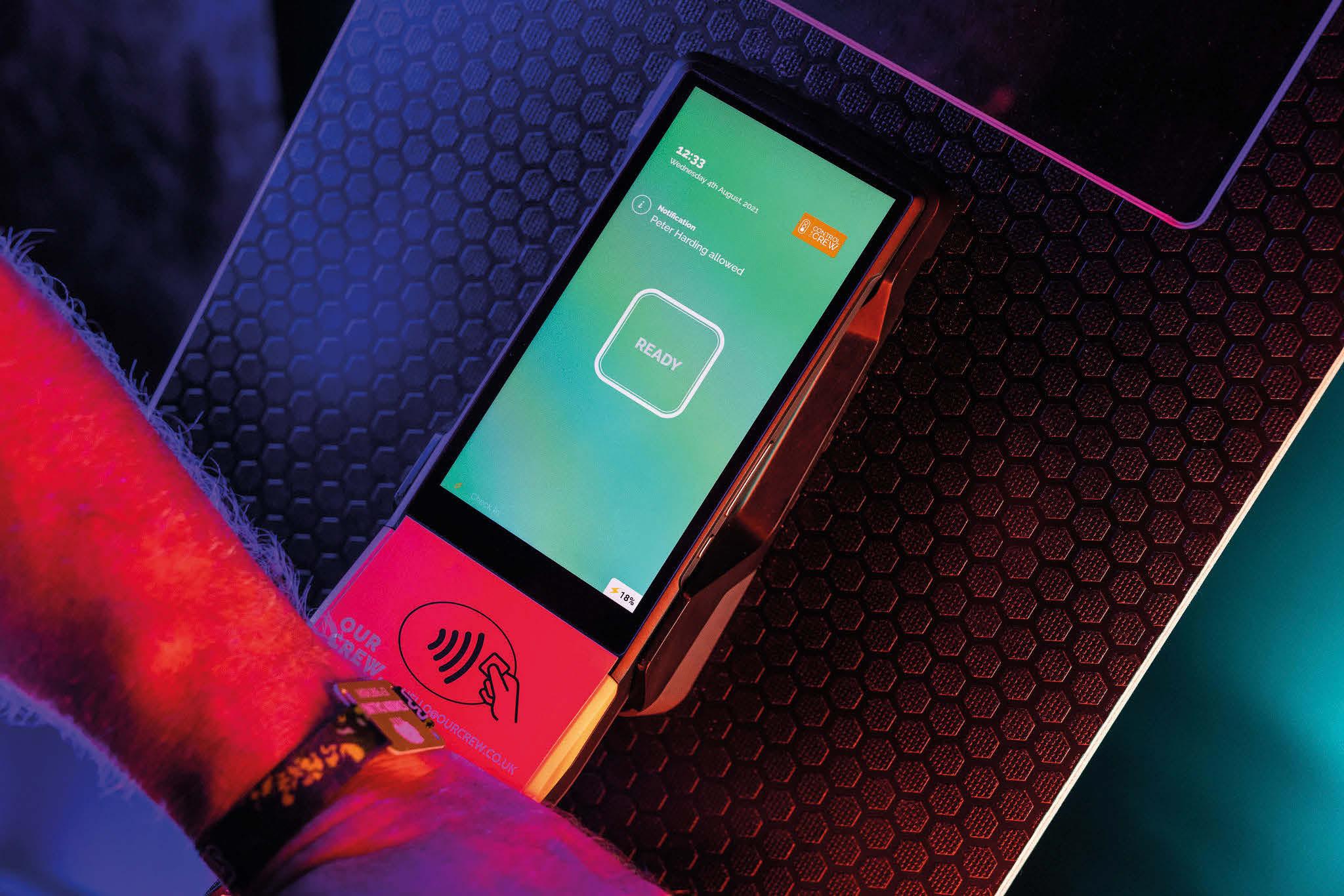
been requested.” Eat To The Beat once again collaborated with Youth Production Network (YPN) as an integral part of its scheme to bring young people into the industry.
“We’ve had so many people leave the industry over the past two years and we’re in need of an influx of people to come and take their place,” stated Shelley-Smith.
Founded by Rachel Haughey in 2010, the YPN is one of the first organisations to support young people in the industry, and provides hands-on experience working on site at live events. One of the main things that separates YPN is that within the scheme, those young people who have shadowed on a few shows can become the crew chiefs of others on the YPN pathway. This means that those starting out are always part of a guided crew, and the crew chief positions support the next generation of production and technical managers as first time team leaders.
“This was our seventh year at Glastonbury, and the largest ever onsite festival training crew across eight production areas. Prior to this, the Interstage team was aided by volunteers who were not always the most reliable,” commented Haughey. “The people from YPN offer roles to all those who want to get into production. So, along with helping Eat To The Beat, we also had crew supporting the Pyramid, Other, Acoustic and Park Stages, Williams Green, Silver Hayes and the BBC Introducing Stage. Each person had to do at least three Eat To The Beat shifts to prove they can get stuck in, before moving on to work with the stage technical teams and joining the exclusive YPN backstage technical tours on the Pyramid and Other Stages. In response to the unprecedented shortage of crew across the industry, this year’s YPN Glastonbury team was an incredible reunion of new generation crew from across the world, all ready to stand up and make their mark.”
TPi spotted many familiar faces while walking around the site from some of the live events industry’s leading manufacturers, who were all on site to get some one-on-one time with end users as well as help in any way they could.
Over the three days, TPi spent some time with the likes of Avolites, DiGiCo, Robe, CHAUVET Professional and EM Acoustics – all of which seemed delighted to be back in among the festivalgoers.

At FOH at the Pyramid, TPi caught up with David Bigg from DiGiCo to discuss his Glastonbury experience. “DiGiCo is always here on this weekend as it’s an ideal time to checkin with customers, but this year was crucial as we hadn’t seen many of the engineers in such a long time,” he enthused. The Pyramid stage featured an audio design from Ben Milton, which included a flipflop A, and B system – ensuring quick and efficient changeovers.

The audio system, which was supplied by long term Pyramid Stage supplier RG Jones, included a console setup featuring a pair of DiGiCo SD12-96 and another for programming at FOH, and two SD10s on stage. “Everyone has a show file for t hese consoles, so all the engineers are happy, which is ideal as production is keen for as many people to go through the house consoles as possible,” said Milton.
“T he A and B SD12s went through a Quantum 7, so any spoken word and VTs could be mixed on the Quantum 7 and then sent out to the PA. The Quantum 7 is crucial in the audio chain and its dual engine is vital. I wouldn’t want anything else as a final single point. It was also great to have Mark Saunders, Dave Bigg and Tom Williams, who do a great job on site supporting RG Jones and others.”
The team also aided Mark Bott of SWG at the Park stage with the SD10 at FOH paired and the SD12 for monitors. Also under the SWG banner on site was the Introducing Stage, which featured a pair of S21 consoles.
Representing CHAUVET Professional on site was Arnaud Thaler, who gave some highlights from this year’s festival from the manufacturer’s perspective. One was in the Circus Big Top tent, where LD James Loudon made use of 12 Maverick Storm 1 Spot and an

equal number of Maverick MK3 Wash fi xtures provided by Fineline Lighting. Loudon ran his lighting rig on a ChamSys MagicQ MQ500M.
“The Storm 1 Spot gives me quite a few options,” he said.
“T he zoom range is lovely, allowing us to cover the whole stage, or focus on a single performer. T his is t he first t ime I have used the MK3 Wash and I was very impressed by its enormous power.”

A collection of 15 Maverick Storm 1 Spot and four Storm 1 Wash fi xtures were used to illuminate the famed Rave Tree in the centre of the Greenpeace areas of the site. “Sustainability is a key consideration for our area of the festival,” said Benji Bailes, who served as Lighting Director and Director of Creative Technology for Greenpeace.
“We’ve done a lot of work in reducing power consumption across all areas, and as we’ve built our entertainment offering and increased our lighting package, it’s clear that now, we can only use LED lighting fi xtures.”
In addition to the Rave Tree, the Greenpeace Area featured the Sun Stage, which hosted a variety of pop, folk, and electronic artists. Supporting t heir performances were fi ve Maverick Storm 1 Spot fi xtures, and a v ideo wall made up of F4 IP video panels, deftly used by Show LD, Belinda Best.
The team at CHAUVET Professional also highlighted the number of ChamSys consoles on the site. The MagicQ MQ 500M Stadium, which was introduced during the pandemic in 2020, was the house desk at seven stages, including the Park Stage, supplied by SWG Events, where Ed Warren used it to run Four Tet’s headline show, and on the Acoustic Stage, supplied by Fineline Lighting, where Patrick Sollitt relied on its seamless cloning and morphing to make last minute changes for headliners Paul Heaton and Jacqui Abbott. SWG Events and Fineline Lighting also provided ChamSys consoles for many other stages. This year was t he first t ime t hat Avolites Diamond 9 console had been used at Worthy Farm. It was the demands of Bloc9 East, hosting ICON – the epic monument, which debuted at Glastonbury in 2019 and featured a 65ft head as its centrepiece – and several alternative performances, that led the D9-215 to be used to control the lighting for this stage.
“T he Avolites team was thrilled to be back in t he fields of Somerset, and we are t hankful to all those LDs that adopted Avolites as their console and platform of choice to power their ultimate performances,” said Paul Wong, Managing Director of Avolites. “It has been a great k ick off to t he festival season and we are looking forward to the upcoming performances
lined up for this summer.” The 2022 rendition of Glastonbury was a significant year for EM Acoustics as this was the first time its speakers had been used on the site.
In conjunction with De Brabant Audio the brand was used on the Acoustic Stage. In total, eight HALO-A were used per side, underpinned with sixteen Quake subwoofers arranged as four blocks of four. Eight R10s provided front fill and outfill. EM Acoustics also supplied a full monitor package of R12 side fills, ST-218 and ST-215 subwoofers and sixteen M-C15 stage monitors. Everything was powered by DQ20D amplifiers in their bespoke touring DQRacks.
“EM are not necessarily known for rock and roll systems, but we are gaining a lot of traction, and some serious interest, in this area. It was great to get the HALO-A system in front of engineers, and in front of an audience, at such a brilliant festival,” enthused Mike Wheeler, Operations Director for EM Acoustics.
“We received universally positive feedback about the system. In particular Sean Kelly, FOH
engineer for Paul Heaton and Jacqui Abbott had never used an EM Acoustics PA. His first impression was that there weren’t a lot of boxes hung, considering the size of the tent, so he was a little worried that there wouldn’t be enough level. However, after listening to a couple of tracks before line check it became apparent that there was more than enough headroom to play with. He also complemented the smooth crossover between the low-mid and the sub, which made it sound like there was zero overlap between the two, and a clean sounding top end.”
While the punters will no doubt have been wowed by the likes of Billie Eilish, Sir Paul McCartney, Kendrick Lamar and the many others who performed throughout the weekend, for those inside the industry, Glastonbury in many ways proved to be the very best version of what a trade show should be.


As well as its primary purpose, the festival provided opportunities to meet old friends from
the industry, exchange ideas and war stories from the previous years, and see how the latest technology can be utilised by some of the best crews in the world.
And the fact this all takes place in a field in mostly sunny Somerset is the cherry on top. Thanks to everyone who took the time to speak to TPi – we’re already looking forward to doing it all again in 2023. www.glastonburyfestivals.co.uk www.libraryproductions.com www.rgjones.co.uk www.negearth.co.uk www.ct-group.com www.stages.co.uk www.skanpa.co.uk www.4wall.com www.swgevents.co.uk www.arcadiaspectacular.com www.videoillusions.net www.nslproductions.com www.finelinelighting.com www.ypn.international


An
Words: Stew Hume Photos: PRG

Among the myriad images from productions around the world this summer, the enormous water tower-esque, video-clad structure that popped up in the centre of some of France’s most famed stadiums – including Stade de France – for Indochine’s Central Tour 2022 certainly garnered its fair share of attention.

With a stage design inspired by a sketch from the French pop rock band’s frontman, Nicola Sirkis, the resulting show design proved to be an inspiring challenge for the technical teams to bring this vision to life. “Nicola wanted to offer an unforgettable experience to all the fans. Building a 360° tower in the middle of the stadium with the audio and lighting inside would allow everyone to see better and be immersed in the pure musical performance and the artistic presence,” explained Stéphane Desch, Director of Production. “He sent me multiple sketches of what he had imagined about two years ago and we started from that. In fact, the result is very close to his original concept.”
To bring this concept to life, the Production collaborated closely with PRG, which provided lighting, video and rigging for this project. Also involved were suppliers Stageco, providing the staging, while MPM Audiolight supplied all audio requirements.
Having worked with the band for the Stade de France performances in 2014 and 2010, Stageco was the natural choice to take on the responsibility of building the ambitious stage design, which aimed to keep as much of the staging infrastructure as possible hidden from view, including both the rigging and the PA.
“T he main brief of the show was that everything had to be contained within the towers and under the deck,” began Stageco’s Operations Manager, Tom Bilsen. “The structure had to take 110 tonnes of rigging loads and the deck sub scaffold was opened as much as possible to accommodate six ‘caves’
for artists, dressing rooms and production items.” The nature of the show meant that all departments – from staging, to audio, lighting, and video – had to work extremely closely with one another to turn this show into a reality.
“It was intense,” confirmed Bilsen, who added that having so many “known faces” in other departments meant at least he and his team knew what to expect.
For each date of the tour, the build took a total of 48 hours, with 17 supervisors split over two shifts. The tear down on the other hand took 20 hours. “Being able to do a full test build and rehearsals at our premises helped all of us to learn a lot and get a clearer view on task split, schedule and expectations,” stated Bilsen.
“During the rehearsals, lots of open issues and change requests from the band were resolved during that build and we all got familiar with the intense build and tear down touring schedule. We also did a partial technical test build back in October 2021 in Belgium, Tildonk,
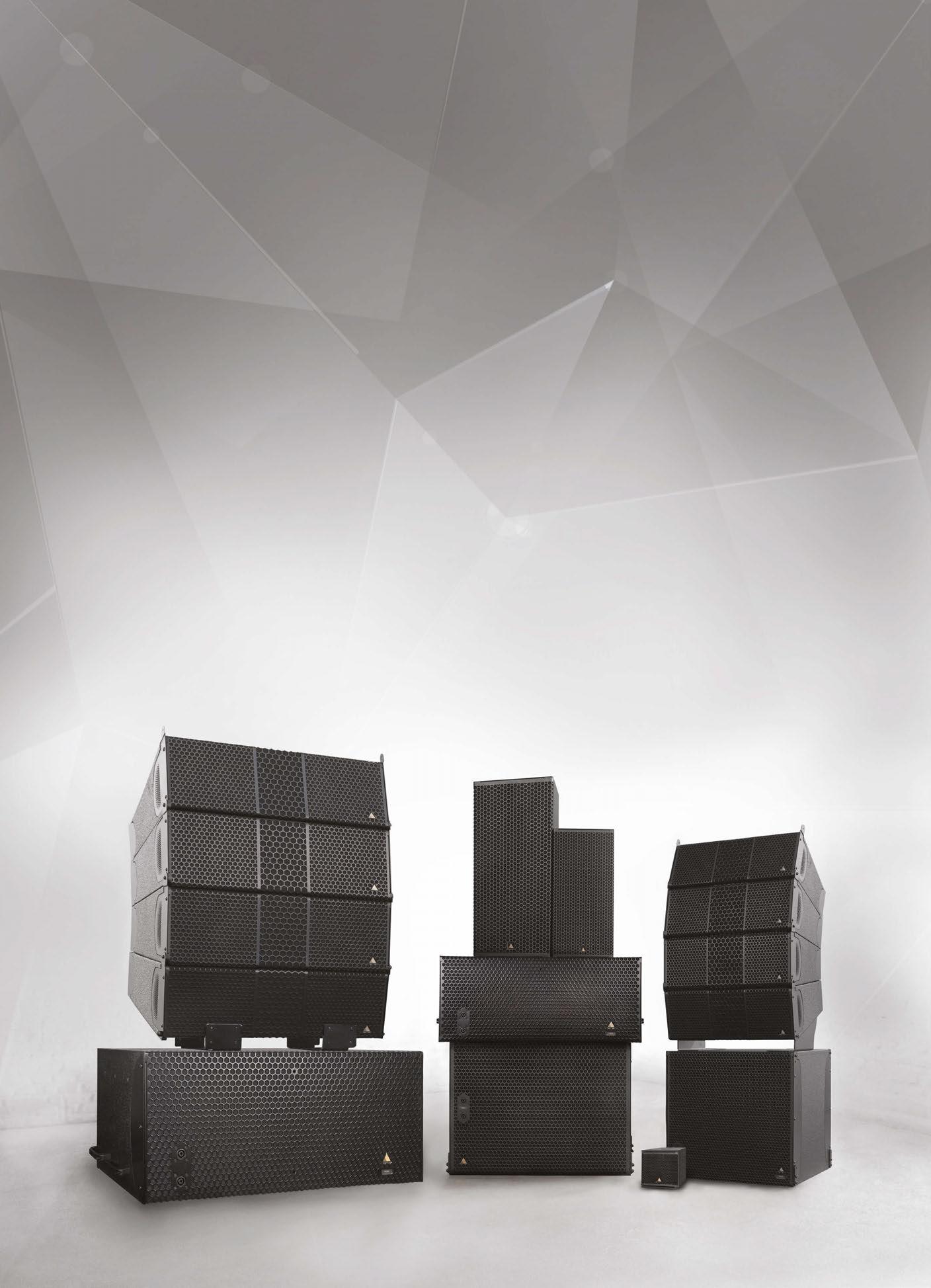
where PRG and Stageco are both located, to test the impact of hiding the PA system behind the video screen.”
The lighting and the video packages were handled by two branches under the PRG umbrella – namely PRG France and PRG Projects. The video tower was made of specially manufactured Titan-X LED along with PRG’s latest innovation, the SoundBlast Solution. While part of the PRG team started drawing up technical plans and diagrams of the tower, PRG Projects started developing and manufacturing the Titan-X LED product with INFiLED that would make this endeavour possible. In response to Nicola Sirkis’ vision, the 360° tower was fitted with a customised LED screen, developed and manufactured
developed by PRG Projects in 2017 and, according to Opsomer, it was essential for the tour. “Spaceframe gives the rental panel structural strength without adding trussing,” he explained. “It allows the rental panels to take care of the wind loads. This is the real differentiator when it comes to strength. Also since Spaceframe does not require any additional trussing, it saves a lot of time during installation and reduces transport costs.”
INFiLED and PRG worked together closely to develop the TITAN-X. From the first drawing to a 1,850 sq m setup, the collaboration and the combination of PRG’s knowhow and INFiLED’s agile developing capability played a major role. R&D teams from Belgium, the UK and China worked tirelessly during more than nine months on this project and created a robust, mesh rental and touring solution with the foldable X-frame structure for a new level of stability.
“We’re delighted to have collaborated with such a long-term and strong partner like PRG on this impressive project,” stated INFiLED CEO, Michael Hao.
Opsomer added: “INFiLED is a very capable manufacturer that understands the quality needs of the concert touring market. By adding our market expertise, we were able to jointly bring a unique solution to the market.”
Dr iving all the content to the Titan-X screen as well as the ROE Visual CB5 central screen were seven disguise gx 2 media servers. PRG Technical Director, Romuald Beaufour, who drew up the plans and initial diagrams of the tower, added: “The installation of our Titan-X in stadiums was sometimes complex because the tower protruded from certain stadiums in height, which posed problems for the municipalities. To comply with the relevant legislations, the tower had to withstand a 72kmh wind speed for three seconds.”
specifically for the tour, providing a solution that integrated the sound system, lighting and all the cabling within the tower behind the LED screen, to be as streamlined as imagined.
“W hen we saw Nicola’s drawings, we saw that there were some challenges. Firstly, we had to find a solution to place the sound behind the video screen and there was no solution to that at the time,” stated Frederic Opsomer, General Manager of PRG Projects. “Secondly, the height of the screen meant that we had to create a new, very light product that had all the features of the PRG Spaceframe, including wind bracing, built into it. At the same time, we needed a product with a transparency of over 70% to allow the sound to penetrate from the back of the screen into the stadium. This meant that we needed to develop a new product.”
The PRG Spaceframe product range was
One of the creatives working with the massive LED canvas was High Scream’s Romain Pissenem. Having worked with the band previously on their video for the song Nos Célébrations, Pissenem was excited to be on board for this live project.

“T he whole experience was very personal for me,” he enthused. “I was dancing in my bedroom as a kid listening to Indochine and working with them 30 years later was surreal.”
With frontman, Nicola Sirkis taking on the role of Show Designer, Pissenem got to work closely with his childhood idol. “He had a very clear vision of what he wanted. It’s been an honour to work with such a talented artist with over 40 years of experience in this industry and still pushing the limits.”
The sheer scope of the stage show created an interesting challenge for Pissenem. “From building this massive structure to creating the content, the fact that it is 360° means that you must give the same emotion to everyone at the same time but showing different images,” he shared. “It’s been a dream come true to


be able to play with more than 2,500 sq m of LED.” Pissenem added that one of the main challenges was providing intimate moments during the show and not being overpowering. “When you have such a big structure, you have to be careful to use it subtly,” he noted.

The PRG lighting rig comprised 1,360 fixtures, including LED Striplights and Floods, Martin by Harman MAC Viper Wash, GLP impression X4 Bars, LITECRAFT OutLED AT10.plus, Elation Professional Proteus Smarty Hybrid IP65, and PRG GroundControl Longthrow Followspots.
“T here were a lot of challenges in terms of lighting, which is mainly due to the 360° configuration of the tower,” described Lighting Designer, Jean Christophe Aubrée.
“T he idea was to be able to create some volume in all of this and to use the surfaces, seats and structures of the stadium a little differently.” To this end, the team positioned lighting in all directions, from both inside and outside of the tower. “We also had to carefully consider the size and weight of our fixtures, since they all had to fit into the tower. Working with a 3D model allowed us to visualise the project more effectively,” Aubrée explained.
The lack of visible PA is a striking feature of the design, which allowed for the content
displayed on the tower’s 360° LED to be enjoyed by everyone in the stadium without any obstructions. PRG Projects carried out numerous tests with several audio manufacturers and developed the SoundBlast Solution, which uses the weight of the audio as ballast behind the LED screen to support the weight and structure of the LED installation.
“T he Titan-X and the PRG SoundBlast Solution will allow us to take a step forward in the development of large videos and video content design because being able to place the sound behind the video screen has been the dream of all designers,” stated Opsomer.
David Nulli, Technical Manager of MPM Audiolight, which has been providing sound for the company since 2015, talked through the audio deployment. “Nicola was very particular in that he didn’t want to have any clusters of speakers around the screen,” he began. “It was impossible for us to have the most powerful PA and a good sound image of the stage with PA flown under the screen. So, we decided with DV2 – Adamson’s France distributor – to design the PA configuration behind the screen.”
Af ter numerous tests with PRG, the production ultimately engineered a behindscreen array, which incorporated four different PA cluster configurations. There were four clusters of 18 Adamson e15 and three e12, another four of 21 e15 and three e12, four of 12 e219 subs and then a final eight clusters of four
s10. On the floor there were 32 e119 subs, 32 S7s, eight s7Ps and eight s10Ps. For the upper tiers of the stadium, 14 clusters of six e12 were then deployed for flown delays.
“T he band have been fans of the Adamson brand for many years and it’s an integral part of their sound,” stated Nulli. “The group and their engineer, Olivier Lude, especially like the low mid of the Adamson speakers – particularly on the guitar.” Nulli went on to complement Adamson’s Energia System for the homogeneity of a large spectrum of frequencies in a large distance.
“The Energia contributed especially well for a stadium tour to preserve a large spectrum frequency in seats,” he stated. On both ends of the optocore, DiGiCo Q7s looked after FOH and monitor duties with an additional SD12 that handled a premix. Monitor Engineer, Lionel Pelatan also made use of Klang Fabrik 3D immersive system for the artist on stage. “After a long break for our company due to COVID-19, it was so exciting to make a big show with a lot of Adamson equipment,” stated Nulli, adding that the largest challenge was that nothing like this had ever been designed before for a stadium concert.
In total, 250 technicians were mobilised for the entire tour, and more than 950 shift workers were hired. The show was truly an international effort, with nine different
nationalities represented in the PRG touring crew alone. “Whether it was PRG Belgium, PRG Projects or PRG France, everyone got involved in this beautiful project,” enthused Laurent Boillot, Production Director, PRG France.






“We brought people together from all over the world to grow this team for the tour. It was wonderful to see the synergies and sharing of knowhow, but the success of this adventure is also a choice of companies with whom we collaborated. Everyone contributed to this. Whether it’s Stageco for the structure or MPM for the sound, all this is a big part of the success of the adventure.”

Th e tour certainly pushed the envelope even further in terms of what can be achieved with an in-the-round production and was another example of how ingenious engineers can open even more doors to show creative content while not in any way jeopardising the experience for the paying customer. www.indo.fr www.prg.com www.mpmgroup.fr www.stageco.com www.high-scream.com
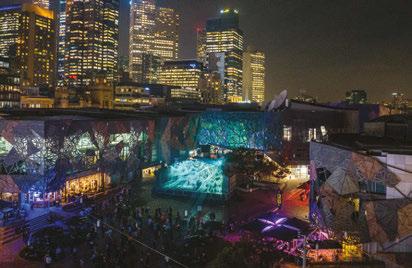


BST Hyde Park returned to crowds with a new headline sponsor and revamped staging infrastructure. Taking place across three weekends from 24 June to 10 July 2022, this year’s line-up boasted headline sets from the likes of Elton John, The Rolling Stones, Eagles, Adele, Pearl Jam and Duran Duran, as well as support from rising stars in the shape of Phoebe Bridgers, Sam Fender and Tiana Major9, among many others.
Describing the festival as a “touring stadium show with a corporate finish”, Technical Production Director Mark Ward of Proper

Productions oversaw all technical aspects of three stages – from stage to audio, lighting, video, and artist liaison – dealing with over 130 performers across three weekends.
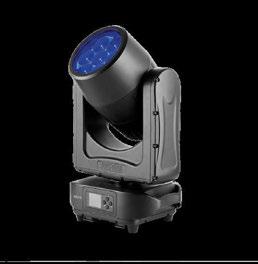



“This is not a typical inner-city festival; the nature of it changes each day based on the line-up,” Ward reported. “Striking a different attitude throughout the squad and ensuring the gear is well-maintained requires a slightly different mindset and approach.”

Having been involved in the project for almost a decade, Ward has witnessed firsthand the evolution of the festival. “We want to

elevate the festival experience and be among the best festival sites in the world. There’s not a single white tent in front of house – it’s all sets and scenes, which requires investment over a sustained period to create an event that really stands out.
“The whole team really care about delivering value throughout the site, including production, for some of the biggest headliners in the world,” Ward said, referencing as an example the vast amount of work that went in to re-imagining and re-building the festival site’s iconic Great Oak Tree, designed by Es Devlin and constructed
We’ve already planted 50,000 trees, and with every line array cabinet we now sell, we plant another tree.




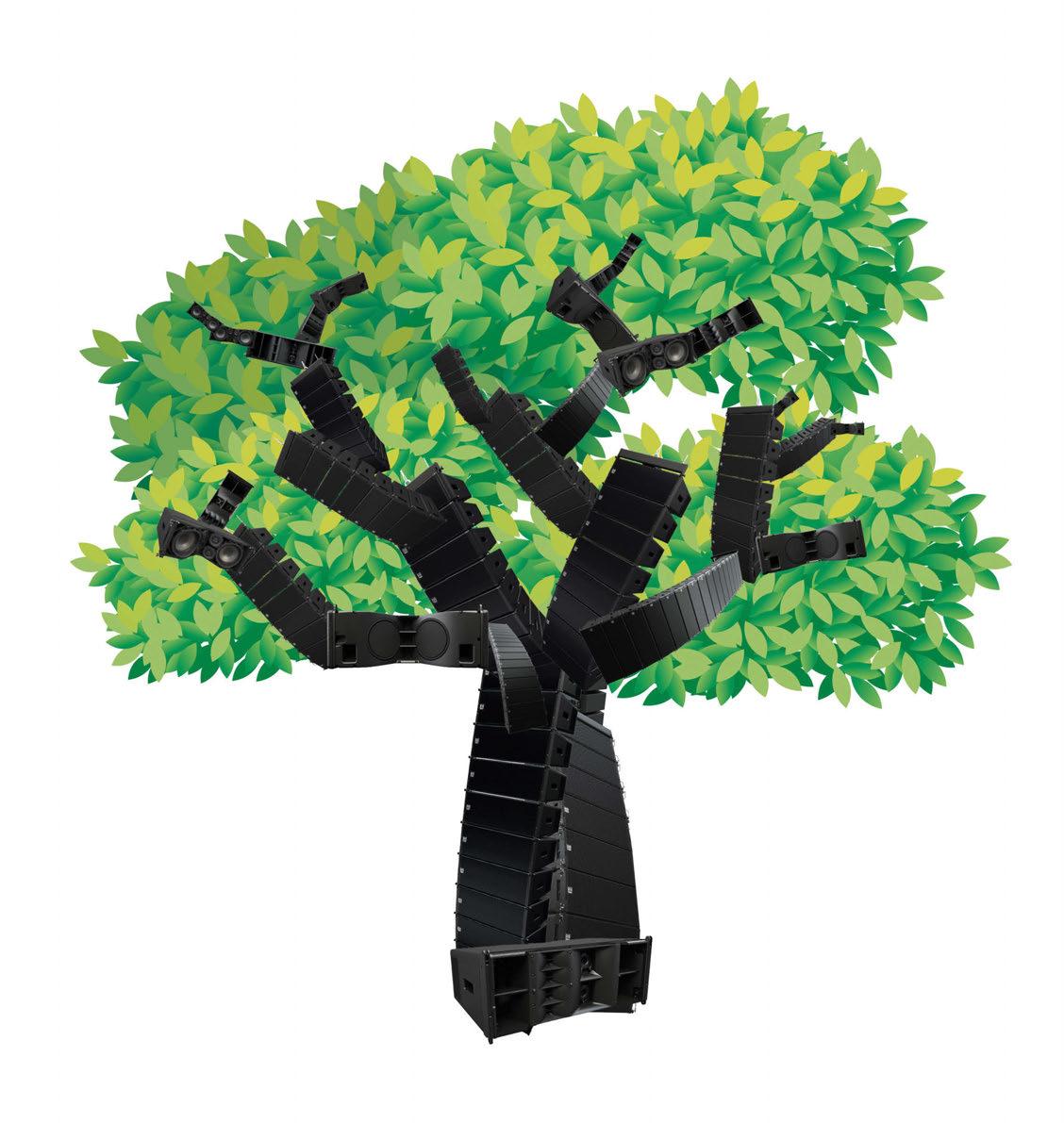
So, with Wavefront Precision not only do you get class leading coverage, consistency and control, but you also help restore the environment. Sounds doubly good to us.













were on stage,” he said, reserving individual praise for the Star teams “amazing attention to detail” on the two different thrusts added for the Stones and Adele’s performances – with Adele’s B-stage coming in from Stage One to connect to Stars thrust. “There have been challenges, but our suppliers have been great.”
Taking note of the additional 5m height gain of the Titan stage, which reached 19m off the ground, Solotech extended the two main PA and sidefill hangs and streamlined the 11 delay towers, introducing its recently acquired Martin Audio WPL scalable line array. This resulted in no fewer than 182 Martin Audio line array elements being deployed at the event as well as 44 subwoofers. The main PA this year was increased by four elements and comprised 19 MLA and a single MLD Downfill each side, with 15 MLA and an MLD Downfill as side hangs. Arranged in a broadside cardioid array were 32 MLX subwoofers while six pairs of MLA Compact provided front fills.
The delay positions were also extended with longer hangs. Of the 11 masts, positions one to five were configured with seven MLA and an MLD Downfill; the Delay masts six to nine behind the FOH mix tower comprised an extended 10 WPL and three SXH218 in a cardioid stack, while Delay points 10 and 11 were each populated with eight WPC elements. Wavefront Precision enclosures were driven by Martin Audio iKON multi-channel amplifiers in the optimum one-box resolution, and the sound was again carried site wide on an Optocore fibre ring, which offered full redundancy.
As for the video displays, Solotech provided a near 1,500 sq m LED screens measuring over 16m high for the main stage including 4,500 Saco tiles and 540 ROE Visual CB5 LED panels on the main stage screen. A further 300 CB5 panels were deployed for delays, relays and for Stage 2. “There were a lot of conversations about how to make the PA sound great and feel


in proportion on Star’s Titan stage. Solotech and Martin Audio got fully engaged in figuring out solutions and we more than achieved the result we were after – both sonically and aesthetically. It looked ‘right’ and sounded great,” Ward enthused, citing the sitewide support of AEG Presents (promoter), LS Events (event management), Star Live (staging), Capital Sound (audio), and Vanguardia (sound management), Solotech (video), PRG (lighting), First Call (rigging) GIG (catering) and Stage Miracles and The Production House (crewing).
“We are always open to new ideas but if we’ve been given great service, we’ll stick to it,” Ward said, praising the roster of vendors. “The site staff have also done an incredible job of putting this together. Arranging fencing, ground cover, services and toilets and all the other stuff no-one really notices is, in some ways, more challenging than technical production gear.”
With the schedule upped from two to three weeks, Ward was conscious of the demand on crew. “If you put together a reasonable schedule with the manpower to achieve it, nobody should be getting pushed too hard. We staff this project accordingly, tell everyone what is expected and if they’re struggling, we help them out,” he noted, citing the presence of Music Support on site.
As a founding member of The Tour Production Group (TPG), Ward places great emphasis on sustainability in his decision making, with the site using Hydrotreated Vegetable Oil (HVO) for power generators and enlisting the support of A Greener Festival’s Claire O’Neill as a Principal Advisor. “It’s gradually becoming part of the process for event organisers to respond to increasing demand for sitewide eco-friendly practices from artists and management,” Ward remarked.
Supporting Ward with the day-to-day was Senior Production Coordinator, Tyler Cole; Production Coordinator Owen Donkin and

interning Production Assistant, Fríða Frosta. “Part of our job is to bring the next generation of talent through the door. We have a responsibility to be a part of that process and thankfully we’ve been able to introduce graduates from the Royal Central School of Speech and Drama into the sector and provide valuable insights through work experience.”
Having started as an intern in 2015, Cole has climbed the ranks to Senior Production Assistant. “With Harry Ford out on tour with Ed Sheeran, I stepped into his role, working closely with Mark on advancing and the build. It has been great to deliver this show on such a big scale with some of the biggest artists in the world in a more all-encompassing role,” he concluded. “We work with a team that is world class. The suppliers, account managers and crew have all put in the hours to create the best possible experience for the people who bought the tickets.”


www.bst-hydepark.com www.properproductions.org www.solotech.com www.martin-audio.com


Helen Swan of Lucid Creates introduces the company’s latest immersive installation created for cinch presents Creamfields 2022.
Known for its propensity for large LED screens and jaw-dropping productions, UK dance music mecca, Creamfields, has always pushed the envelope when it comes to stage design – and that certainly didn’t change in 2022. Not only did organisers launch a brandnew festival – Creamfields South – but the northern rendition of the event now benefits from a brand-new stage by Lucid Creates.

Runway was designed and fabricated by artistic studio Lucid Creates, known for creating ground-breaking stages, structures and art installations including Parklife’s The Valley and the LS23 space at Leeds Festival.
The company prides itself on producing environments that push boundaries – where audiences and artists connect and converge through music, sound, and visual language. These goals were very much on display when it came to Runway.
“O ver the years, we’ve invested in our own kit and core components to create some
incredibly bespoke solutions,” began Helen Swan of Lucid Creates. “This means we can create some really unusual structures.”
The bespoke nature of Lucid’s designs stems from the mentality of ‘what we want to do’ as opposed to ‘what we can do’. “When we
showed Momentum – our structural engineer partners – our initial designs for Runway with the huge LED screen that extends out to the audience, they thought we were bonkers,” Swan said, laughing. The overall goal of Runway was to create a stage that was equally as
Photos: Lucid Creates“When it comes to designing a show, you need to create something that is worth leaving the house for. We don’t want to just create something to look at from a distance - we create spaces in which people can be part of the experience.”
Helen Swan of Lucid Creates
impressive from a distance as it was for those close to the artist. The space can hold 20,000 festivalgoers with a 60m by 30m LED screen that extends over the crowd from above the DJ.

The d ance floor is t hen lined by 8 m by 12m high towers lined with video. Aiding in the delivery of this show was Video Illusions who provided the LED, with Zeal Live working on the lighting design for the shows. Also key to the creative process is Matt King.
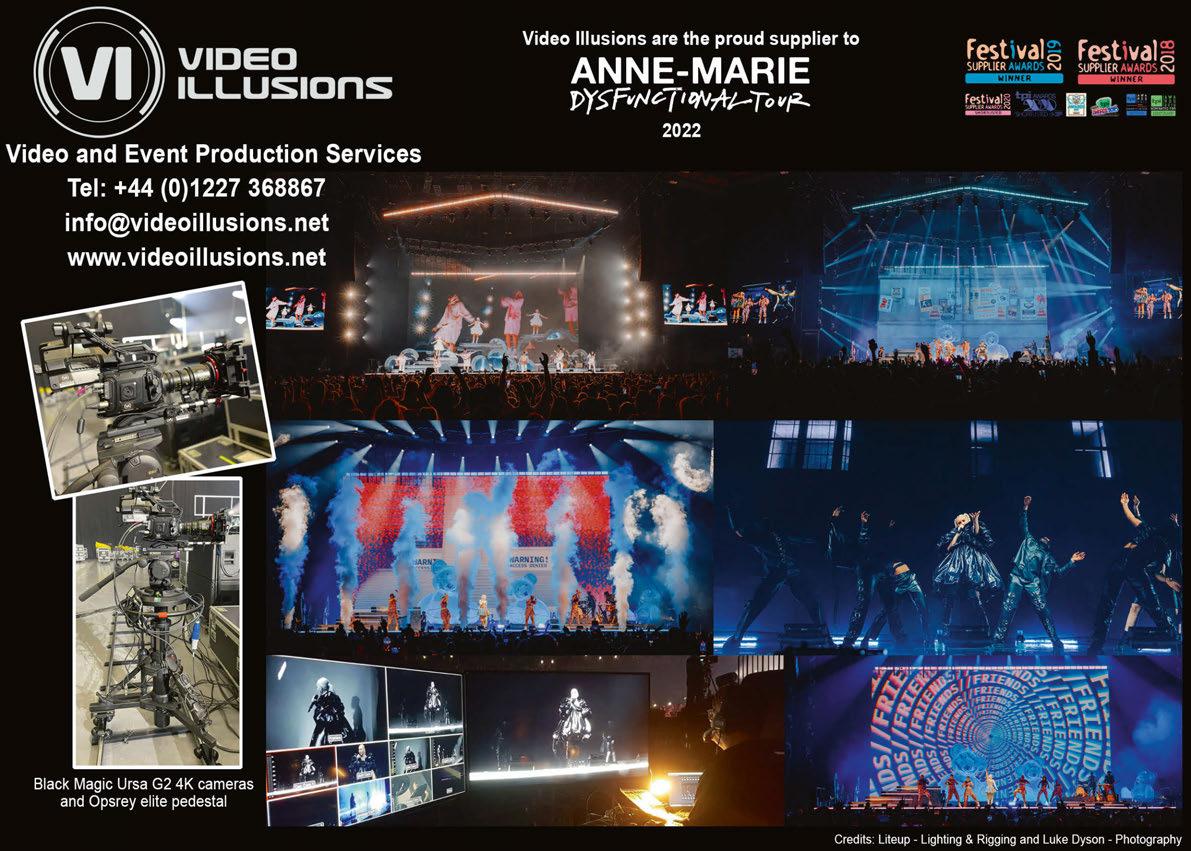
Known for his work with the likes of Eric Prydz, King helped the Lucid team realise their vision to truly immerse t he Creamfields audience in t his new space.

“I ’ve got three teenage sons; what they experience in the VR and gaming worlds is so all encompassing and thanks to Discord they are always with their friends,” King informed TPi ahead of Runway’s debut.
“So, when it comes to designing a show, you need to create something that is worth leaving the house for. We don’t want to just create something to look at from a distance – we create spaces in which people can be part of an experience.”
www.lucidcreates.co.uk www.videoillusions.net www.zeallive.com
In what has become a long-term collaboration, the d&b audiotechnik team was once again back on the WOMAD Festival site deploying its Soundscape system on the d&b Stage and being utilised by artists including Joe Armon-Jones, The Selecter, Hollie Cook and SEED. Overseeing the d&b Stage was FOH Engineer, Gavin Tempany. Although he has worked on the festival a number of times in the past, this was his first time working with the Soundscape system and TPi was keen to get his thoughts on the experience.
“O ver the years I had worked on this particular stage using the SSL desk when it was still named the Bowers and Wilkins Stage, but I had never worked on this one with the Soundscape install,” he began. For this year’s setup, there was a front array of several speakers across the stage with some out fills along with a delay setup halfway down the tent to bring the front image more to the rear of the
tent. Then there was a ring of speakers making up the ‘surround’ element of the show. “For most of our visiting engineers, this was the first time they had Soundscape or even an SSL Live console,” he added.
To aid any incoming engineers, Tempany and his team set up two consoles at FOH – one to build show files on during acts and another as the show console. “This was of great help,” he recalled. “Sam Bath from SSL and I guided them through this process. They all took to it very quickly. Sam had built a comprehensive template and had done the work of importing the channel names into the show files – using the CSV import feature on the SSL – so it was all very organised.”
When it came to Soundscape, Tempany explained how different engineers had various approaches to how they utilised the immersive audio system. “Everyone took to it very quickly,” he stated. “Soundscape is very natural

sounding. The inbuilt reverb in soundscape places everything in the same cohesive space by default, so the result is very good right from the begining.”
He went on to give some of his highlight performances from a Soundscape perspective. “I really liked the mix of Hollie Cook. Being a dub-style act, it was very suited to the delays and effects being manipulated in Soundscape. Top marks to their engineer, who mixed the show on a new console and system and it sounded stellar. Onipa, one of our last acts on Sunday, was also very well suited to Soundscape, with great use of effects.”
The production was even able to accommodate an incoming Allen & Heath touring package used by Icelandic singersongwriter Ásgeir Trausti. “It integrated seamlessly over Dante into the Soundscape and the visiting engineer was very happy with the result,” informed Tempany.
d&b audiotechnik once again brings the immersive experience of Soundscape to the annual celebration of world music.








Not only was Tempany looking after FOH during the festival, but he also got a chance to mix on the system for those bands without engineers.
“I particularly enjoyed mixing a band from the Congo called Fulu Miziki Kolektiv. They made all their instruments in the loading bay from recycled plastic containers, 100mm drainpipe and flip-flops. When I told their manager about Soundscape, he was very encouraging to make it as ‘spatially interesting’ as possible. It turned out great. If I can mix a band who built their obscure instruments in the car park, and have a good result, then anyone can do it!”


Speaking more generally, TPi asked if Tempany thought it was likely to see other similar immersive setups at festivals in the future. “Yes, this is definitely where I see it going,” he enthused. “Having a specialist stage at a festival with this installed is something I can see working at other events. At WOMAD, we consistently had audience members commenting on how much they enjoyed being in the tent. A lot of them were very astute to the movement and panning. Others just thought it sounded great, without articulating why.”
He did however predict there might be some resistance from some engineers to fully embrace the system thinking it might be difficult to convert their current mixes to the Soundscape workflow.
“However, the fact is the process of converting an existing mix into object-based showfiles is easy,” he commented. “You can keep your normal left and right assignments, but the feed to the PA is done from post fade direct outs from each channel instead. “A lot of
engineers will find it a bit disconcerting there is no L/R bus – especially given the festival protocol of only being able to soundcheck on headphones – but it works very well to just make a master or band VCA, and use that for volume trim or control, as you don’t get traditional bus-based compression or EQ.”
As for mixing on Soundscape, Tempany described it as “just the same as usual”.
He continued: “As long as the routing is taken care of, it is just like mixing on a big

‘stereo’ rig, but with the added advantage that you have all the space and height in the mix that you normally have to work for.
“It’s a lot like transitioning from stereo mixing to surround mixing of music in a studio. Things find their own space much easier with less manipulation, and if you want to spin things around, you can do that as an added dimension for performances.”
www.womad.co.uk www.dbsoundscape.com
“At WOMAD, we consistently had audience members commenting on how much they enjoyed being in the tent. A lot of them were very astute to the movement and panning. Others just thought it sounded great, without articulating why.”
FOH Engineer, Gavin Tempany
Change is not evident,
www.dts-lighting.it

The annual celebration of the UK festival industry returns this December, remaining the only festival focussed awards providing fans the opportunity to vote for their favourites.
To be held on 6 December at Manchester’s Escape to Freight Island, the UK Festival Awards presents the ideal opportunity for festival organisers and suppliers to get together and reflect on the past season whilst looking forward to the next.
The awards themselves will be decided by either fan votes, an expert panel, or a combination of both in categories including: Best Major Festival, Outstanding Contribution and, for this year only, the Perfect Pivot Award, which acknowledges the festival business that applied its skills to alternative activities amid the COVID-19 pandemic.
With awards ranging from grassroots to large and categories for family and nonmusic festivals, organisers Festival Insights is expecting record numbers of votes, with the public having the say in more awards categories than ever. Andrew Parsons, Managing Director, Ticketmaster UK said:
“We’re proud to partner with the UK Festival Awards for the fifth year running. Festivals are a cornerstone of UK culture and it’s so important we recognise the hardworking people behind the scenes who make them happen. Manchester is the perfect host city – home to so many artists, venues and teams central to the festival ecosystem.”
Mayor of Greater Manchester, Andy Burnham, commented: “Everyone in Greater Manchester knows the massive global impact this place has had on music and culture, so it’s fitting to see the UK Festival Awards coming to the true home of 24-hour party people.”
After what’s been an exceptionally tough time for festivals and the hospitality industry, it’s really important that we get behind the sector and recognise the many people – from organisers, to caterers, to volunteers – who deliver everything from boutique independent events to some of the biggest shows on earth.
We can’t wait to welcome all of this year’s nominees to Manchester and celebrate their achievements with them.”
Sacha Lord, Night Time Economy Adviser for Greater Manchester, stated: “The UK Festival Awards is an annual highlight for the industry. Now in its 19th year, I’m absolutely delighted that they have chosen Manchester as this year’s host. A city that’s known for its rich tapestry of festivals, the acknowledgement is testament to everyone behind the scenes that make them happen. I look forward to attending, celebrating and throwing my full support behind it. Manchester is truly open.”
Commenting on the move to Manchester, Festival Insight CEO, Andy Lenthall concluded: “Manchester’s rich cultural heritage, its vibrant festival scene and great selection of cool venues make it an ideal choice for our first move out of the capital.”
www.festivalawards.com

When Las Vegas’ non-essential businesses closed their doors to the public in March 2020 to prevent the transmission of COVID-19, it was the first time that the city’s iconic neon Strip had dimmed since President John F. Kennedy’s funeral in 1963. As the sleeping giant of live entertainment strives to recapture its former glory days, supply chain and workforce challenges continue to plague its progress. However, amid the drudgery of a citywide rebuild, there are pockets of positivity in the bustling warehouses and offices of Las Vegas’ PRG, 4Wall Entertainment, and Main Light West.
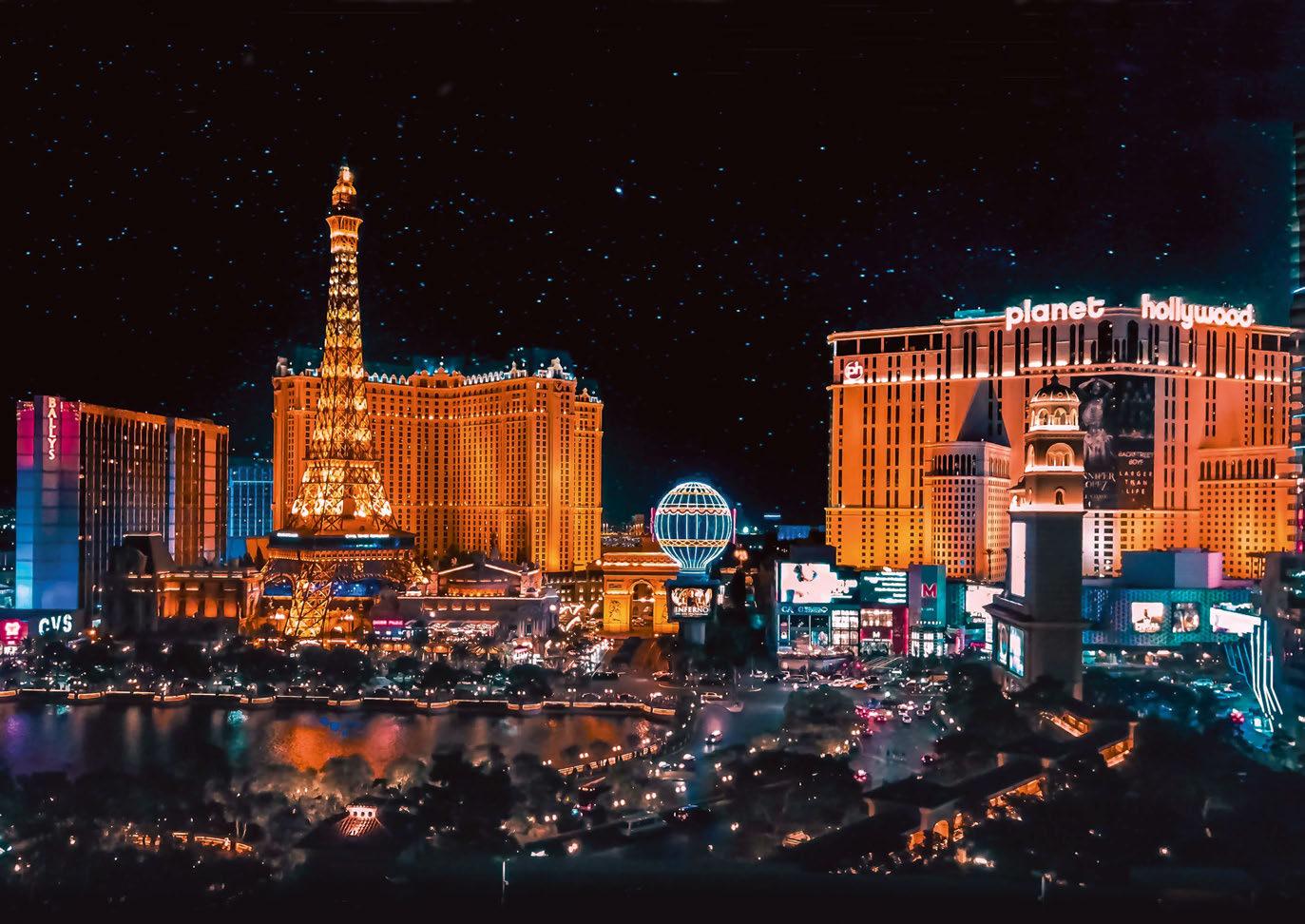
With four decades of experience in the lighting industry, 4Wall Regional General Manager of the West Coast and Senior VP, Larry Mikalishen was well-placed to spearhead the Las Vegas office’s response to COVID-19. “The pandemic affected us greatly,” he began.
“We kept thinking that this would be a threemonth issue, yet here we are two-and-a-half years later, where it’s still posing an issue.”
With non-essential businesses closing, the lockdown was an ideal time for refurbishments and lighting systems refits.
“Our Systems and Integration department was extremely successful in helping us survive the pandemic,” Mikalishen noted.
“A ll of our locations stayed open during the entire pandemic servicing TV, virtual, and other
forms of business, but Las Vegas, in particular, was mostly doing Systems work.”
PRG’s Las Vegas office echoed these sentiments. “Thankfully, we have a great crew, who were highly understanding of the challenges we faced and stuck with us as and when we required their services during the lockdown,” said Adam Parrish, PRG General Manager, Las Vegas.
“One benefit of the lockdown was getting all the equipment back in the warehouse to sort, catalogue and identify shortfalls in some of our processes to implement procedures to improve our workflow.”
Like most companies, PRG pivoted to provide alternative events. “It was nice to see the company adapt to what the clientele requested, such as virtual and remote solutions, and provide new offerings and alternative virtual solutions,” Parrish acknowledged.
PRG Scenic Technologies’ sales team pivoted with what they were chasing from corporate and touring events to interactive experiences, car shows, and refurbishing establishments across the Strip.
“We chased new markets, and the company survived the pandemic as a result of innovating and adapting to emerging markets,” Kyle Garrelts, General Manager of Operations and Engineering at PRG Scenic Technologies,

clarified. “Automation was a life raft for us in lockdown. Typically, you’d see variable speed hoists at every gig. However, with the lockdown of live events, companies and buildings wanted to refurbish their systems. We ended up with refurbishment and fabrication projects all over the Strip.”
In lockdown, PRG Scenic Technologies also updated and improved internal processes within its facilities, reducing costs where possible with novel additions like censored lights throughout the building and restructuring rooms to allow for growth in departments as well as examining resources, people, material and inventory.
“We started by turning unknowns into known factors,” Garrelts remarked, explaining the choice to develop an inventory system to analyse the cost and availability of materials and the availability of vendors. “We’ve adapted with what’s going on in society and we’re ready to jump back on the horse.”
Having spent 21 years on the books of 4Wall, Vancouver-born Mikalishen highlighted why, despite the past two-and-a-half years, Las Vegas remains the opportune place for growth. “First and foremost, Las Vegas is one of the top convention areas in the country and that makes up a large part of our business. Secondly, the
PRG, 4Wall Entertainment and Main Light West share Las Vegas’ road to recovery, after the city’s iconic Strip switched its dazzling neon lights off to the public for the first time since 1963.

Strip’s attractions – casinos with showrooms – are ideal for our Systems Integration department. We also have an airport to provide international travel links, allowing our team to focus on global projects,” he continued. “It’s a great city to do business in.”
Capitalising on the demand for entertainment technology in the city, Main Light – the largest national dry hire provider in the US – expanded its operations amid the pandemic with the formation of a new 40,000 sq ft shop at 6435 South Valley View in Las Vegas. “This is the opportune city to set up shop in because of the demand for convention work,” suggested Main Light West CEO, Randy Mullican. “There was no other strictly dry hire company before we moved in. It’s a great time to service the market without competing with local rental houses.”

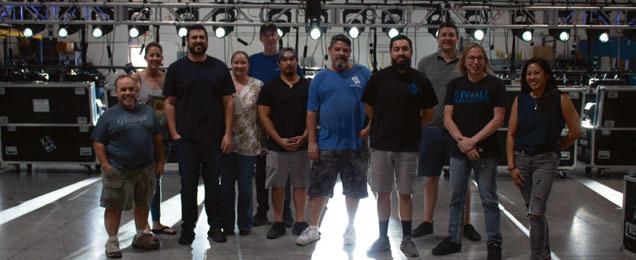
Throughout the pandemic, Main Light took the opportunity to rebalance its inventory by selling off older equipment and acquiring gear in demand by production companies looking to supplement and access quality equipment from a trusted dry hire resource.
Setting up shop in Las Vegas, it appears, was anything but a roll of the dice. “Looking back on the decision now, it was great foresight. We’ve curated a cohesive group which collaborates well together, and they truly care about the sector and one another,

which is a testament to the company,” Mullican reminisced. “Fundamentally, this business is about the people and treating the customers how you’d like to be treated.”
From next to no income to sporadic employment integrating systems and delivering virtual or behind-closed-doors events, coupled with shortages of experienced crew and ever-increasing shortfalls of the supply chain, the issues the industry has faced and continues to face are many and wideranging.
“Our largest struggles right now are hiring people to fill positions and having equipment delivered on time,” Mullican outlined.
“T he supply chain is incredibly challenging; fortunately, customers are a lot more flexible and understanding of this as it’s a global issue.”
With the supply chain an enormous problem for all industries, 4Wall – which operates a used and new gear shop – continues to invest in available equipment, albeit, not at the same rate as pre-pandemic.

“We had to slow down our typical workflow of selling used gear because replacements simply aren’t arriving fast enough,” Mikalishen reported. “Even getting gear to events nowadays is difficult with a shortage of trucks and drivers. The fuel prices are rising, so when trucking costs are the same as the rental, it’s rough.” Highlighting further problem areas such as manufacturing lead times on product and
sourcing materials, as well as an in-demand, skilled workforce, PRG Scenic Technologies’ paint department has focused on expanding its services and capabilities. “This became a necessity due to client demands, society and the evolution of shows,” Garrelts said, highlighting the firm’s increasing focus on flame retardant applications.
“T his new service will call across all markets and is something which we have not focused on in the past. Now, the whole team will be trained for flame retardant applications.”
Las Vegas doesn’t have much competition for flame retardant applications, however, PRG Scenic Technologies is slowly beginning to shift its tack to provide solutions for interactive experiences, such as creating bespoke flower walls for events and providing artistic lighting fixtures for ceilings the length of two football fields of lights for the likes of Van Gogh Exhibition: The Immersive Experience
Over time, Las Vegas has grown to accommodate the increasing demand for live entertainment. With tourists and revellers flocking back to the city amid the return of in-person live events, alongside hybrid and remote productions, servicing the needs of audiences and clients with solutions of varying demands and complexities will be key to sustained success. “We’re continuing to see more stadiums, arenas, and convention centres built here,” Parrish proclaimed.
The new BBT truss from HOF is the strongest aluminium truss in its class and can take a distributed load of 20 tons over a span of 30 metres. It offers maximum flexibility with a minimum volume: the BBT has not a single welding seam and is completely bolted. This makes it possible to replace - for example - damaged truss directly at the venue. The BBT is available with 3 different bracing sets; depending on the load requirements, the appropriate bracing can be installed. The truss can be dismantled very easily if necessary, and thus offers an incredibly low transport volume: up to 150 metres of truss can be transported with only one truck.



“There is an ever-growing demand for live entertainment and production support throughout the entire city. A lot of sectorspecific companies in Las Vegas work together, rent equipment and execute shows together depending on availability of kit, staff and timing.”
Connecting companies in the area, not only to unify standards in Las Vegas but also to support each other and collaborate on projects, is at the core of PRG’s ethos.
“In today’s market, it’s difficult to hire. If we need to find a carpenter for a week or two, I’d rather contact a local company for temporary staff to maintain the core of Vegas,” Garrelts continued. “Our current goal is personal and personnel development – improving workflows, systems, and inventory. Not only does this grow our individual skill, but our communications and toolsets also improve.”
Meanwhile, Main Light West’s immediate goal is the acquisition of new equipment,
increasing its available inventory to provide solutions for more customers. “We have a good spread across good market segments in the touring and production, conventions, corporate and industrial shows, as well as the house of worship market,” Mullican revealed.
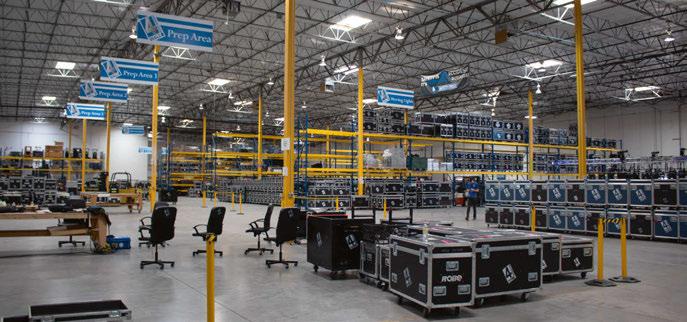


Spending time with Las Vegas rental and dry hire outfits, it’s apparent that a ‘people and quality-first’ approach is key to the challenges that lie ahead. With a lot of experienced technicians leaving the sector, introducing, nurturing and accelerating the progress of talent considerably faster than pre-pandemic levels in order to plug the gaping holes left by the COVID-19 pandemic is at the forefront of the city’s road to recovery.
“It’s interesting to see a shift in talent, as the next generation of crew come through the door and offer opportunities for those from alternative sectors,” Garrelts observed.
“Our aim is to maintain the quality that we’re known for amid all the issues of the rapid
restart. We’ve hired people who are proud of our product and take pride in making our clients happy,” Mikalishen added. “We are constantly increasing our fleet of gear and our workforce. In the rental industry, if you invest in moving lights, you need cable, distro, and consoles. Everything you buy requires infrastructure.”
While the next few years may be the sector’s toughest in recent history, they may also breed creativity and innovation in the way productions are catered for and how audiences consume live entertainment.
“I ’ve seen a great deal of technology shifts during my time in the industry, and the pandemic has pushed even more boundaries. It’s an exciting time for all of us as we see Las Vegas evolving and improving the ways entertainment can be delivered,” Mikalishen concluded. www.4wall.com www.prg.com www.mainlight.com
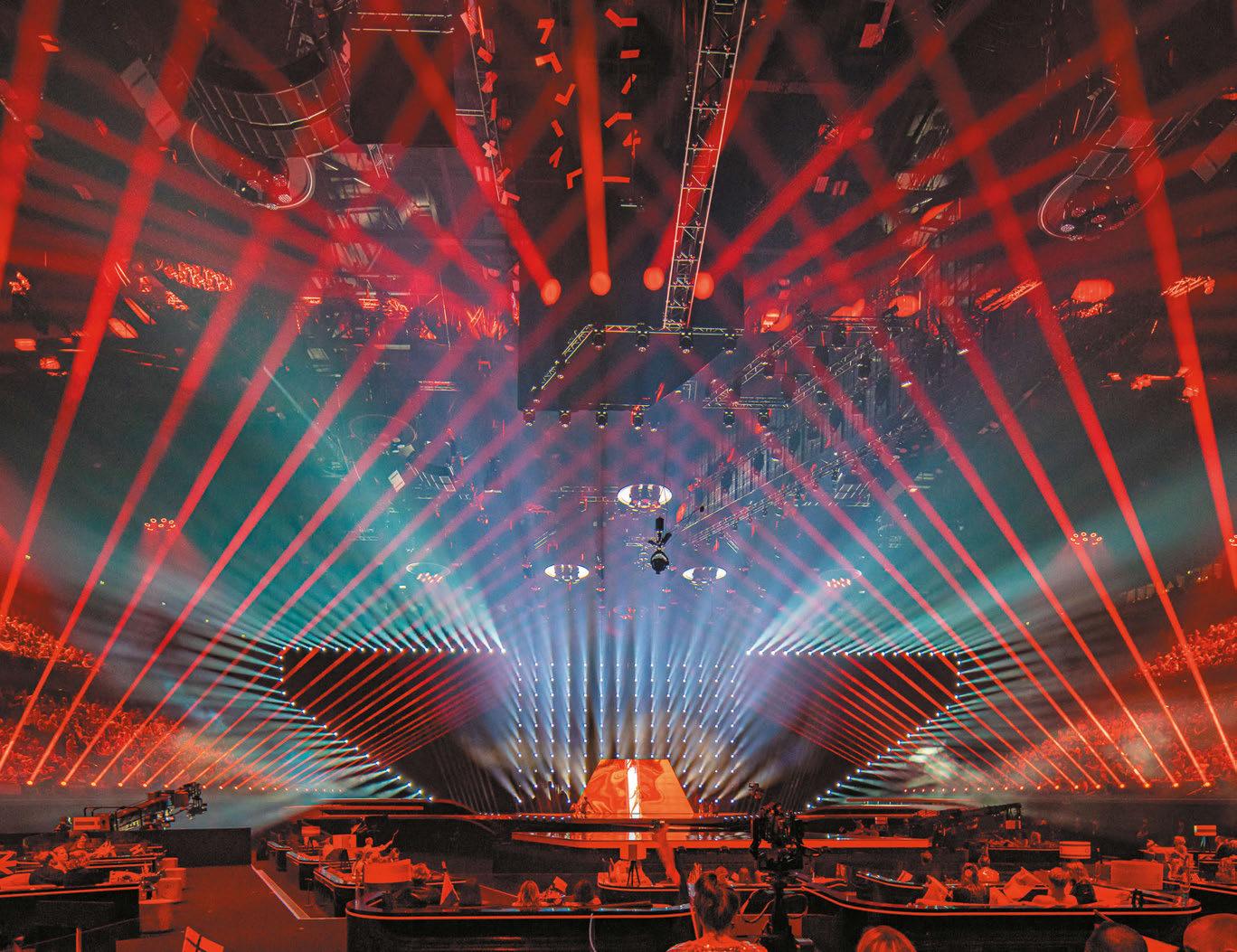







When the pandemic hit in early 2020, live events came to an abrupt halt and rental houses around the world saw their warehouses full to the brim with unused equipment. During this time, many businesses had a similar idea of creating a studio space. The range of offerings went from low-budget DIY streaming stages all the way up to highend XR studios demonstrating the latest in-camera technology. Falling into the latter of these two categories, 80six’s studio space in its Slough HQ has now become a major part of the company’s portfolio and taken on a life of its own.
Having been utilised for music v ideos, film and TV shoots as well as a production rehearsal space for live shows, 80six’s Jack James and Dan Hamill have been continuing to invest in this latest venture both in terms of technology and staff.
Situated just outside the M4 corridor, the studio is found in the adjoining building to 80six’s new warehouse. W ith a 10,018 sq f t studio footprint and an additional 1,725 sq f t open-plan production office, t he space is set up for a broad range of incoming productions. The self-contained unit has ample parking and a loading bay for two artics, and with the warehouse neighbouring the studio, the
company offers onsite technical support as well as t he latest v ideo equipment.
“Our work within the virtual studio market started around 2019 w hen we were speaking to companies including ROE Visual and disguise about t he possibilities of in-camera effects,” ex plained Hamill while discussing the origins of the studio. “ The goal was to look at XR options for t he film and T V industry.” T he company lent into t his in 2020 w hen it moved into a new facility and created what eventually became the studio – although in the initial stages the building also served as the company’s warehouse.
“As we continued to go down this path and set up the studio, we began to get more and more interest from productions looking to shoot music v ideos,” he explained. Following that, we also had many people we work with on the 80six rental side enquiring about using t he space for tour rehearsals. So, t he studio grew naturally before we had even begun to promote it to t he w ider market.”
To d ate, the facility has been used by the likes of Years & Years, who used the studio before their Night Call tour this May, which 80six then provided a video package for during the band’s Wembley A rena performance. Jax Jones and Sugababes also recently used

the space in the lead up to their summer shows. “ We’ve come f rom a live touring events background, t herefore our USP is t he flexibility of our offering,” explained James. “ We are used to operating at large scale events, under tight deadlines , therefore we are more than capable of adapting the space to whatever t he requirement of t he client f rom a simple black box to a curved LED setup or an xR shoot,” he s aid, adding t hat V irtual Production Studios c an be more flexible w ith t he budget of incoming productions t han studios w ith a fi xed setup and as such a ‘ one size fits all’ price t ag. “ For live production rehearsals, we c an c ater for academy-sized acts comfortably, although we have now hosted a smaller Wembley A rena production in t he space,” stated Hamill.
Both Directors spoke candidly about the difficulty of juggling this fledgling studio space along with managing the core 80six business as events return in a major way in 2022. To address this, the company is embarking on a recruiting spree, with the goal of the studio operating w ith its own independent team.
The studio is already booked up until the end of the year, with several clients from the TV and film world along w ith numerous music video shoots scheduled to take up temporary residence in t he coming weeks. “ We didn’t go
 80six’s Jack James and Dan Hamill explain the value that the company’s recently expanded versatile studio space has brought to the business.
80six’s Jack James and Dan Hamill explain the value that the company’s recently expanded versatile studio space has brought to the business.


into 2020 thinking that we would be setting up a studio as its own independent arm of the

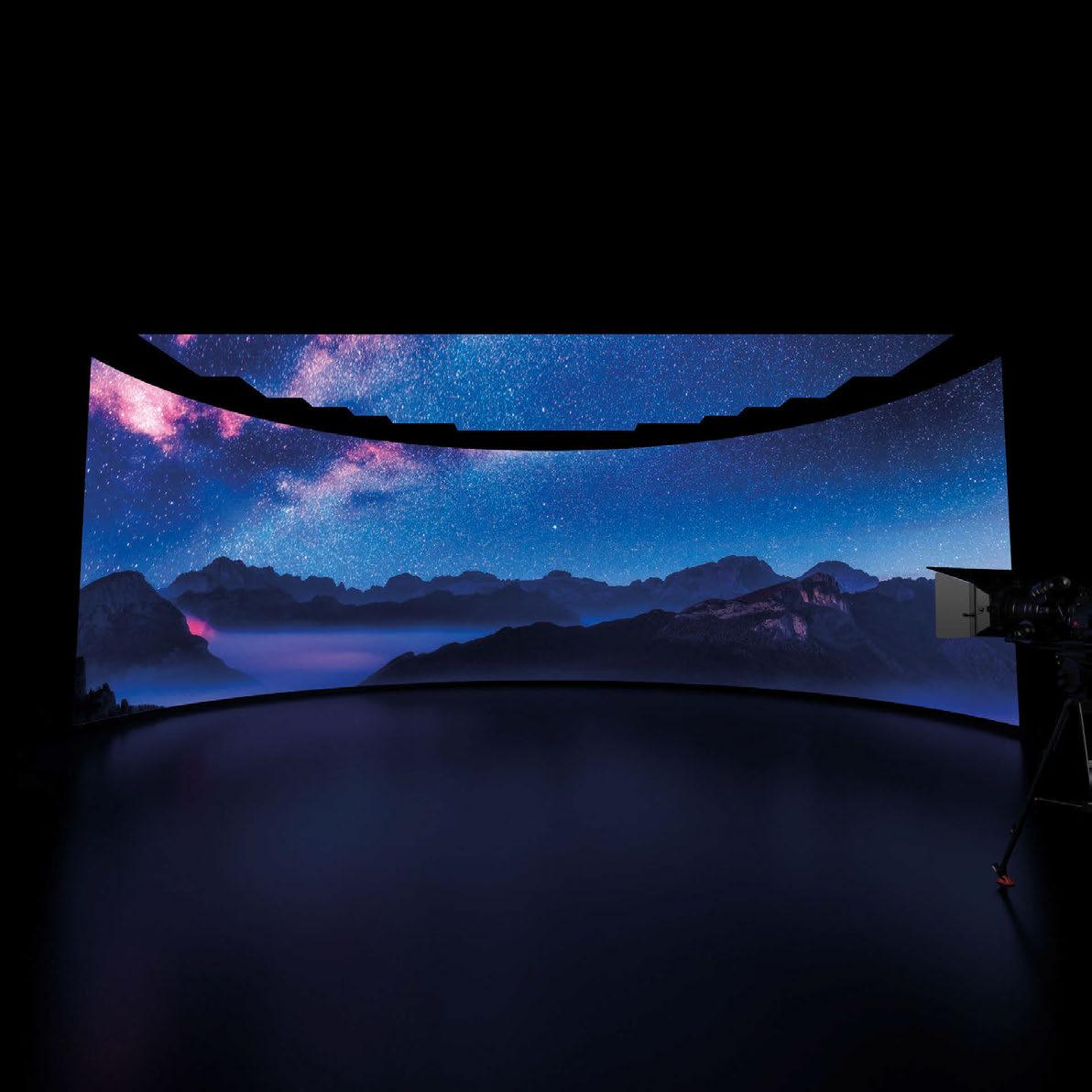

rehearse, so it’s an ideal time to continue to invest in this venture. We’re now offering a very

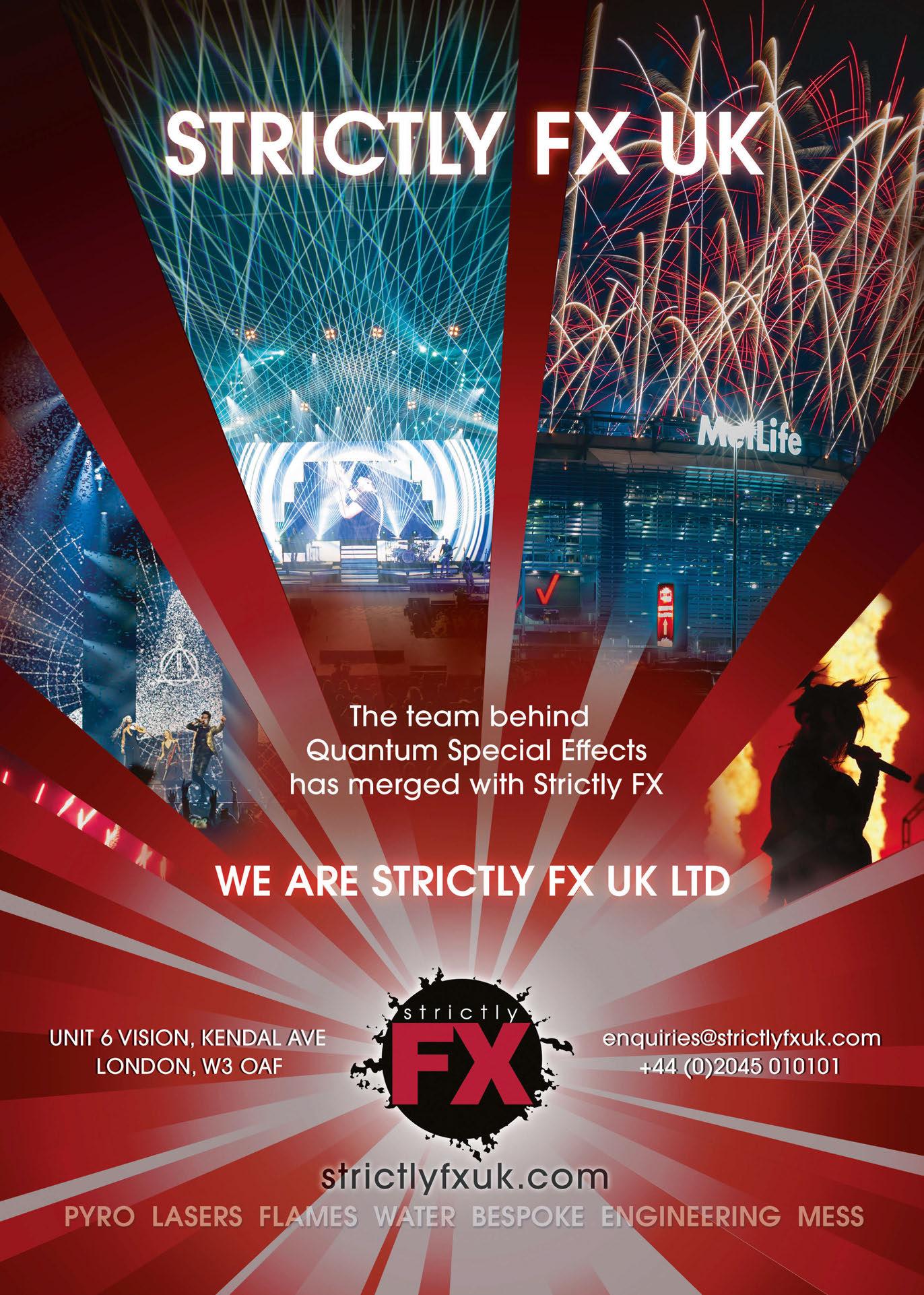
Founded in 2012, Brompton’s roots are embedded within live events. One of the core goals of the company was to address the challenges of using LED video for live events, ensuring not only that the image quality was to the highest possible standard, but also that its products could withstand the rigours of touring and be set up quickly. Since then, while still being the go-to LED processing solution for many productions, the company has seen significant growth into the film and TV industry – something that increased yet further during the pandemic. A decade on, the company now has two core markets – live events and in-camera visual effects – which it holds in equal importance.

“T here have certainly been many changes over the past 10 years,” began CEO, Richard Mead as he spoke to TPi about how the changing demands of the live market are what

saw Brompton start to look at new avenues outside traditional live events. “Many big live events are also televised – such as the Oscars, which we first did in 2013 – and from the outset, the priority was that the LED looked just as good to the camera as to the eye.”
This turned out to be critical to the future of the business as when the film and TV worlds started experimenting with LED in replacement of a green screen, the industry was searching for rental houses to provide LED that looked great on camera, which in turn meant Brompton kit being used on more jobs. “We were there at the start of the virtual studio journey before anyone knew quite how big it was going to get.”
Having been at the forefront of this adoption of LED for in-camera effects, Brompton was in a strong position when the pandemic put live events on hold. “We have been very lucky as the pandemic accelerated the adoption of
virtual production techniques as TV producers tried to respond to the spike in demand for content from streaming services,” stated Mead.
“People were willing to experiment with new techniques who might otherwise have waited, and this fast growth allowed us to pivot away from live events and grow the business through the pandemic.”
Due to this trend, Brompton ended up having similar turnover in 2021 as it did in 2019, despite COVID-19. “In 2019, almost all sales were from live events, whereas in 2021, they came almost entirely from TV and film,” enthused the CEO. “Now, we are seeing live events coming back alongside continued growth in TV and film. We need to expand our capabilities to ensure we can continue to provide excellent support to all our customers and deliver the products they want.”
This need to increase its footprint both in terms of real estate and staff was the reason for the company seeking investment – something they found with Connection Capital, which completed a £5.1m growth capital investment in Brompton earlier this year.
As part of the growth plan, Brompton has just moved into a new HQ in the UK. “Our new building is in Chiswick,” explained Mead. “It’s much larger, with a dedicated demo and testing space on the ground floor. A lot of our capabilities can only be appreciated with inperson demos and it’s going to be great to have a facility where we can bring customers in to show what Brompton is capable of.”
Brompton also has outposts in Shenzhen, Taipei and Los Angeles and through the pandemic these all went through somewhat of a change. “They all had to operate far more independently as no-one from the UK could travel there,” explained Mead. “This meant that lots of people were thrown in the deep end, but everyone rose to the challenge magnificently and the way we operate those offices has changed as a result.”
Like many in the industry, Brompton is currently on the hunt for new staff to keep up with the growth of the company. The CEO
CEO, Richard Mead reflects on Brompton Technology’s 10-year history and explains how the company has maintained its core values while branching into new markets.
(L-R:) Connection Capital Investment Director, Miles Otway; Brompton Technology Non-Executive Chairman, Neil Gaydon; Brompton Technology Chief Financial Officer, Chris Hunt; Brompton Technology Chief Technical Officer, Chris Deighton; Brompton Technology CEO, Richard Mead; Connection Capital Investment Manager, Lucy Merson; Connection Capital Portfolio Director, Scott Barham; Brompton Technology CEO, Richard Mead.
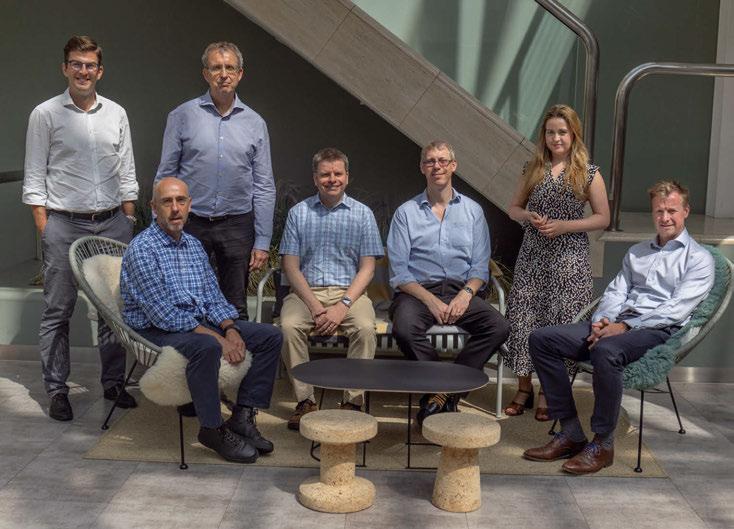
explained: “We are looking to grow the team significantly in the coming months and are on the lookout for people who share our passion. It’s quite a challenging environment to recruit for business in general, post-pandemic, but we are focused on quality over quantity. As a real industry leader, we want the right people who will relish the opportunity to join our excellent team.”


On t he note of new people, the CEO highlighted how the pandemic has drastically altered how the company approaches training. “User training has always been very important to us, and we have always provided free in-person training where possible – but how do you do that amid a global pandemic?”


The solution came from the Brompton team led by Training Manager, Steve Harris, who built an advanced multicamera setup complete with screen sharing that allows fully interactive training to be delivered remotely. “Although we’ve restarted in-person training, we will continue to offer this online version due to its convenience, which enables us to train people all over the world,” stated Mead.
With the ever-expanding footprint in live events, TV and film worlds, it’s surely only a matter of time until there are also new product or software announcements on the horizon, although Mead remained tight-lipped about any upcoming releases for the time being. “We don’t tend to talk about what is coming out until it’s quite well fleshed out. We are constantly adjusting the details of the roadmap in response to customer feedback. Also, as this is a very competitive market, it doesn’t make sense to give more visibility than necessary to those trying to match us.”
That said, with many customers keen to see the latest updates, Mead referred to Brompton’s long track record of delivering major features as free software upgrades. “This means that all existing customers benefit from any new updates,” he stated. “We see this as part of the value of investing in Brompton and hopefully it gives some additional confidence to anyone buying our products.”
With the anniversary of Brompton’s first sale fast approaching, Mead closed by summarising Brompton’s tenth year in business. “Between closing our investment deal and moving into the new building, it has been a very busy summer,” he stated. “We’re certainly planning to mark our tenth anniversary appropriately and we’ll be sure to have a big celebration in the new office later this year.”
www.bromptontech.com
If you look at the changing working practices of crew over the decades, one clear trend is the amount of offline work that happens between shows. From audio engineers using virtual sound checks to hone their mixes to lighting designers using pre-visualisation software – and more recently VR – to ensure that their show looks perfect before an artist even walks on the stage. One department where this level of preparation outside show hours doesn’t exist to the same extent is within video – specifically when it comes to live camera feeds for IMAG content. However, this may be about to change with CuePilot – a pioneering production workflow for planning and delivering live camera cuts.
CuePilot helps show designers ensure the coverage of a live performance is as precise as an edited music video with all cuts predetermined, providing consistency from show to show. Much like most lighting workflows, CuePilot projects are planned in a timeline by adding cues for each planned shot. During a live production, integration with timecode ensures audio and lighting departments are synced with CuePilot.
Meanwhile, the CueApp can be used to cue camera crew and staging staff to ensure the right shots are caught.
CuePilot has already been utilised with live televised events such as the Eurovision Song Contest along with other shows including The Voice Dancing With The Stars and The Masked Singer. It has also been picked up by several awards shows including the MTV Video Music Awards, and used for opening ceremonies for large-scale events such as League of Legends The company is now looking to make similar inroads into the live touring industry.
One Lighting Designer who has bought into the workflow is Manfred Nikitser, who has now made CuePilot a permanent addition to the Scorpions’ live setup. “I heard of CuePilot from a colleague for its use during Eurovision,” he began. “I had never used the software, but when we were preparing for our campaign with Scorpions, I got in touch with the company directly. I originally wanted a solution where I could give the audience multiple perspectives of the show with the camera cuts.”
Nikitser was originally planning on using CuePilot as a cue sheet for the camera

operators, but he soon realised the software presented many more options. “Thanks to CuePilot along with a piece of software called Universal Control, I’m now able to control and oversee all the camera cuts from the lighting desk,” explained the LD.
“W hat’s great about CuePilot is that once you’re several shows into a campaign and the band gets into the groove of shows, you can go into the camera cuts and move elements that either don’t make sense or don’t have as much impact,” continued Nikitser. “For example, we were on a flight from Europe to the US recently and we downloaded our show file from the Cloud and were able to move around our camera cuts so when we landed, we reuploaded the show file, which was then ready for the next performance.”
Nikitser explained that the Scorpions tend to travel light, opting to use local suppliers for many elements of their production, so having this confidence in the camera cut meant there was one less variable to deal with from territory to territory.
“It is refreshing to be able to plan your camera cuts in the same way you would your
 Lighting Designer, Manfred Nikitser explains how CuePilot can seriously change the workflow of live video on tour.
Lighting Designer, Manfred Nikitser explains how CuePilot can seriously change the workflow of live video on tour.
lighting show,” enthused the LD. “Also, the software is incredibly easy to use and lighting designers will be able to get their heads around it in an hour.” Although during the Scorpions’ show, all the camera cuts were automated, the LD was able to manually override the cuts from his lighting desk, which gave him more overall control of the overall visual canvas.
Nik itser also highlighted how CuePilot was equally beneficial to the camera operators


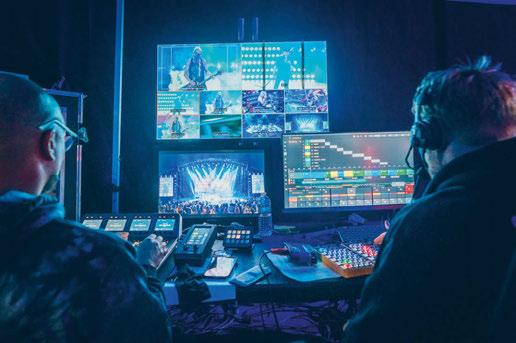
in the pit who can follow along with the cue list and therefore know when they had some downtime between shots rather than having to shoot the show constantly.
Clearly striking the right chord within the Scorpions’ camp, Nikitser is already encouraging others to consider CuePilot for their next project.
www.the-scorpions.com www.cuepilot.com

Already an established name in the events industry, not to mention its work on the international sporting scene, Pains Fireworks is now looking to make serious inroads into live touring.
 Words: Stew Hume
Photos: Cris Matthews (Ed Sheeran), Stephen Collins (The Hundred) & Pains Fireworks
Words: Stew Hume
Photos: Cris Matthews (Ed Sheeran), Stephen Collins (The Hundred) & Pains Fireworks
Plenty of companies working in the events sector can claim a rich heritage, but when it comes to history, there can’t be many that date back further than Pains Fireworks. The Pains name can be traced back hundreds of years and even ties its original founder to Guy Fawkes’ planned ‘display’ at the Houses of Parliament. With documentation of the name cropping up over the centuries as a commercial seller of fireworks to the public, in more modern times, the company became one of the world leaders in largescale firework displays and, as more keeneyed readers will know, Pains Fireworks also recently supplied Ed Sheeran’s monumental +–=÷x Tour [TPi #270].
“I ’ve been at Pains for 15 years and in that time, we’ve had quite a significant shift moving into the special effects and sporting world,” began Tim Griffiths, Sales Director of Pains Fireworks. “We do everything from working with European Rugby, The FA, Premier league and ECB, all the way to the Grand Prix in Abu Dhabi.”
Gr iffiths described how “while we are very used to working on large-scale national and televised events” the company had “never really moved into the world of touring”.
However, having been brought into the Sheeran camp by long-serving Production Director and FOH Engineer, Chris Marsh, Pains Fireworks had its major touring debut on one of the most ambitious stadium runs ever. “I brought in Pains because I trust them, which is key when working on a production this complicated,” commented Marsh, who had worked with the company when he was younger, looking after the audio deployment on several large-scale firework displays as well as on previous Rod Stewart Tours around Europe.
According to Griffiths, many of the skills and knowledge from the special effects world, large displays and sporting applications are transferable to the touring world.
“Companies working in the special effects field tend to fall into very defined brackets,” he mused. “You have traditional firework companies, those that do pyro and flames and perhaps even lasers for events and tours, then
finally you have those that work in the sporting world. We are breaking the mould somewhat by going after a few markets. We also differ from competitors due to the additional knowledge and safety focus gained from our extensive firework background.”
Gr iffiths highlighted how this knowledge of fireworks has prepared the company to provide a better rounded service. “The regulations around the storage of fireworks are strict and as such our HQ is COMAH regulated,” he commented. “This explosives licence is something that others working in the special effects space are unlikely to have and likely only have a local authority licence.”
Pains’ in-house warehouse manager is constantly reading up to ensure they are up to date on all the latest regulations, and the company takes pride in adhering to the
protocols of travelling with mixed loads of dangerous goods. With the focus on safety being of the utmost priority, Pains Fireworks longstanding company protocol was to front the training cost of any incoming technicians.
“We aim to put everyone who works for us through the BPA’s (British Pyrotechnic Association) Qualifications. We’ve been an active member of the BPA and their qualifications give people a good basis on respecting pyro and understanding risk assessments, storage and the various laws surrounding explosives.”
In previous years, Pains’ preference was to always bring people in-house as full-time employees rather than relying on a freelance model. “We have around 120 staff who we use all year round on shows. We also have 15 people in our office in the UK, along with five

full-time staff in our Dubai office and a single member of staff looking after the Irish base.”
The company has also added several sales staff to help grow the business.

With that being said, with the everincreasing list of jobs Pains is now undertaking – not to mention the seasonality of a lot of their firework displays – the company has begun to explore the option of bringing in more freelancers to aid in its increasing workload.


Following the ground-breaking Sheeran show, Griffiths discussed how he hoped the company would continue to push into this new market. “We already do quite a few big gigs out in Dubai – especially when artists come over to do one-off shows – and as such we’re already speaking to some production managers. However, people are often very loyal to their team, and we don’t want to start poaching artists and clients.”
In fact, an ethos that seems to come from the top down at Pains Fireworks is to be as friendly and easy to work with as possible. “We knew that we were the new faces for Ed’s tour, which is a really longstanding, established touring family,” stated Griffiths. “I didn’t want our team to just come in, rig the pyro then disappear until show time. From the first gig in Dublin, all the team were helping other
departments to load trucks, and that ethos continued throughout the run.”
Gr iffiths went on to explain how he thought that this ethos might encourage PMs to bring in Pains much earlier when planning a tour. “Pyro is sometimes the last element to get added to the show; it would be nice to be included sooner so we can provide a more integrated solution, and that is certainly our goal for future projects.”
This planning doesn’t just create more integrated shows, but also saves money for production. “One of the biggest issues we face is the cost of shipping,” said Griffiths.
“A few years ago, sending a shipment to the US would be around $2,500, whereas now you could be talking about $10,000. It has become even more vital that we get sign off for shows sooner than before, as we are needing to plan as far in advance as possible for shows both due to the shipping issues and the differing regulations in each territory when it comes to special effects.”
Despite these obstacles, Pains Fireworks seems to be in a prime position to throw its hat into the ring for more large-scale tours, and the company could well become a staple on supplier lists in the future.
www.painsfireworks.com



Backstage Academy and industry partners join forces to bring live event production careers to life for prospective students across the UK.
Words: Jacob Waite Photos: Backstage Academy
Backstage Academy’s latest tour, which stretched across the UK from the North West to Truro in Cornwall, saw final year students from various degree courses showcase their skills, higher education experiences and encourage prospective students.
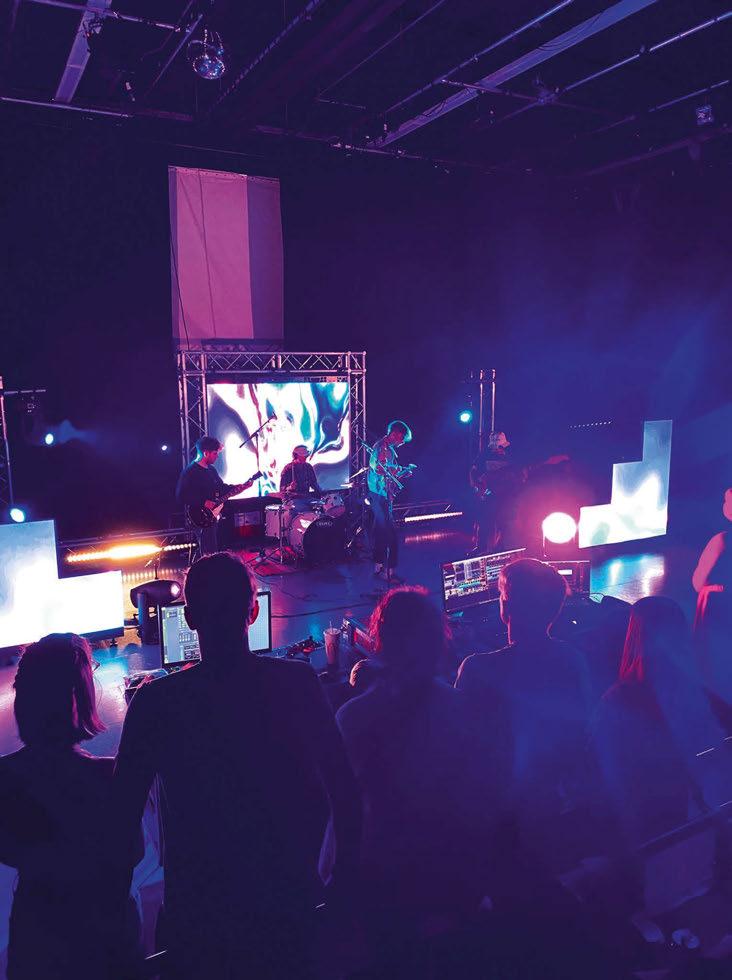
The tour, which was supported by Blitz Rigging, 4Wall Entertainment, Avolites, Sennheiser, Shure, KV2 Audio, Midas, ROE Visual, Green Hippo and STS centred on the technical production of a live band, Listomania, and focused on the core disciplines of live entertainment.
Due to access and time constraints, the tour team designed a ground support structure utilising 30cm trusses provided by Blitz Rigging. This could be easily and manually loaded-in and quickly erected without the use of hoists or forklifts. The structure supported all lighting equipment.
Rebecca Barwell, a Stage and Production Management graduate, led the charge as Tour Manager. “Planning and embarking on this tour has been a great way for us to show any prospective students just one example of what you can do, and the show aspect of the tour allowed them to visually see what we created.”
KV2 Audio provided the main sound system. EX12 mid-highs and the EX1.8 bass enclosures meant that the onboard amplification saved vital van space and weight, yet delivered a no compromise crystal clear sound with pin-point accuracy. Blitz Rigging truss came in the shape of 1/2m sections.
In addition, a wide variety of microphones were provided by Sennheiser and Shure, crucial for capturing every aspect of the four piece band’s performance. Sennheiser EW G4 in-ear monitors enabled the band to receive detailed monitor sound, without the need to transport large monitor loudspeakers, also saving time
and van space. All the audio was controlled using a Midas M32 digital console, supplied by Music Tribe.
A key part of the show were visual images, created and played back by the team on a Green Hippo Amba on a large ROE Visual BlackPearl2 2.8mm pitch LED screen with Brompton Technology processing.
“To be able to deploy such high value, stateof-the-art equipment on the tour was incredible and the results outstanding,” said Alex Sangster, a final year Live Event Production student at Backstage Academy, who assumed the role of Head of Visuals. “It was great to broaden our knowledge of kit and positive to see the responses from prospective students, they relayed feedback about how interested they were to hear more about the courses available and get hands-on with the kit.”
Over 30 lighting fixtures including LED battens, moving head beams, moving head
profiles, spots and blinders controlled by an Avolites Tiger Touch II were used to create an impactful and creative lighting show with kit provided by 4Wall Entertainment.

The UK wide tour showcased what students have learnt during their studies and gave prospective students not only the chance to get their hands on leading-edge equipment and technologies, but help produce the shows as well. “I’ve always wanted to tour and experience tour life, which is what I’ve wanted to go into. I’ve loved every second of it,” Sangster enthused. “Through this experience, I’ve improved my ability to mitigate risks and learn how to problem solve on the road without the comfort blanket of lecturers and teachers.”
Steve Brown, Production Arts & Live Events Lecturer at Truro and Penwith College, said: “It was fantastic for our students to get hands-on experience in the events industry and equally great for our students who will be attending


Backstage in September, who got to meet their soon to be lecturers and fellow students!”
Lighting Designer, James Eccles, who attended Salford City College said: “My time at Backstage Academy has been brilliant. It is totally different from other universities. Backstage is much more career focused and there are lots of opportunities to get hands on with the kit. It’s been fantastic to have the opportunity to showcase what I’ve learnt at my old college.”
Barwell concluded: “The most important lesson I’ve learned from being on the road is to look after each other. Remembering that others in the team are equally as tired as you is key in empathising with others, and at the end of the day if you don’t look out for each other when you’re all in the same vehicle for eight hours travelling to the other end of the country, then who will?”
www.backstage-academy.co.uk
Proper Productions enlists the support of Royal Central School of Speech and Drama alumni, Fríða Frosta and Owen Donkin at the famed inner-city festival site.
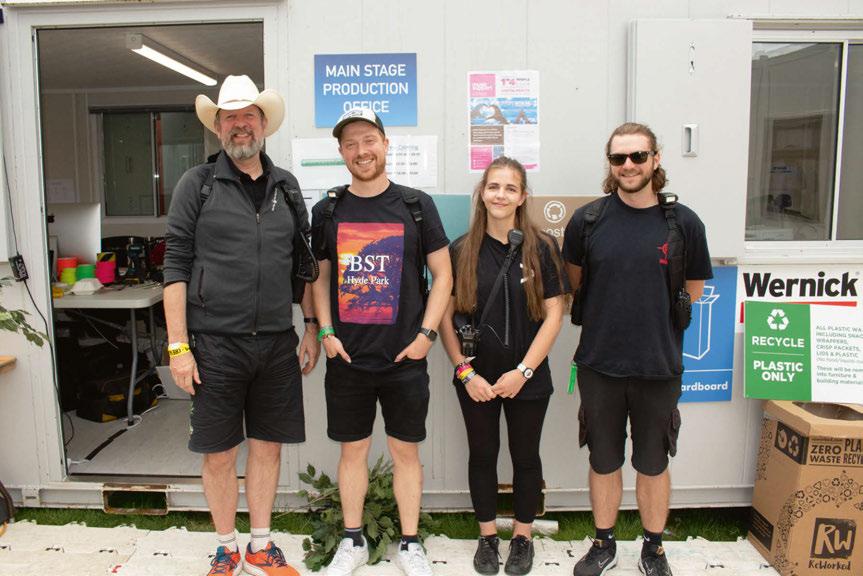 Words: Jacob Waite Photo: TPi
Words: Jacob Waite Photo: TPi
Through their long standing relationship with Royal Central School of Speech and Drama (CSSD), Proper Productions has a history of introducing new talent to the live events sector. Past interns have gone on to advance for some of the world’s biggest festival sites, straight through to tour site managing the likes of Ed Sheeran. At American Express presents BST Hyde Park, CSSD alumni, Owen Donkin as Production Coordinator and Proper Productions intern, Fríða Frosta as Production Assistant and for the festival’s long-awaited return.
As an intern, Frosta assumed the responsibilities of a production assistant across all areas of the festival site to gain maximum exposure and hands-on experience of the sector. “Learning the basics of live events production has opened my eyes to the inner workings of this vast and dynamic industry. Everything from how the cogs turn through to networking with industry professionals with the hope of further employment in the future,” Frosta began. “Witnessing it go from four poles in a field to a fully-functional boutique festival site has been a special experience.”
Frosta and Donkin’s responsibilities varied from pushing papers, raising purchase orders, coordinating paperwork and finances for technical suppliers, as well as making sure hotels are booked, accreditation is dealt with, and coordinating backstage areas with a handover to artist liaison teams in conjunction with Proper Productions.
“It’s been a rewarding experience to work on a production of this scale and learn how to think ahead to mitigate any obstacles, while learning how to problem solve as I go along,” said Donkin, who like Frosta, shares experience producing and managing smaller, theatrical and touring shows.
The added complexities of dealing with a show in the outdoor elements as opposed to an indoor theatre show was a “learning curve” for the recruits. “I have learned a huge amount from being dropped into the deep end,” Donkin noted. “There’s different terminology and sizes of crews at a festival of this scale, and level of attention to detail is as important as ever. Plus, it’s much nicer being outside, as opposed to a dark theatre!”
Frosta concurred: “Realising when to step in or spectate has been a challenge as well as the lingo and terminology, which differs from the theatre world despite crossovers of kit. Especially as English isn’t my first language, as an Icelandic national.”
Donkin highlighted transferable skills involved in both camps. “Our job is to communicate and disseminate information as a team. One of the biggest lessons I have learned has been dealing with last minute requests, rolling with the punches and getting on with it, but also learning to reach out when I’m at capacity and asking for help – as opposed to bottling things up. My advice to those looking to break into the sector is network and communicate with others,” he said.
In closing, Frosta – who was also on site at All Points East with Donkin and Proper Productions – shared her tips for those looking to break into the sector. “I’ve seen the different career paths for live events and theatre, ideally,
I’d like to do both. Thankfully, there’s lots of opportunities available for young people looking to break into the sector. My advice is to start drinking coffee, get lots of sleep and check in with yourself. Network with industry professionals and don’t be afraid to approach people for opportunities.” www.bst-hydepark.com www.properproductions.org
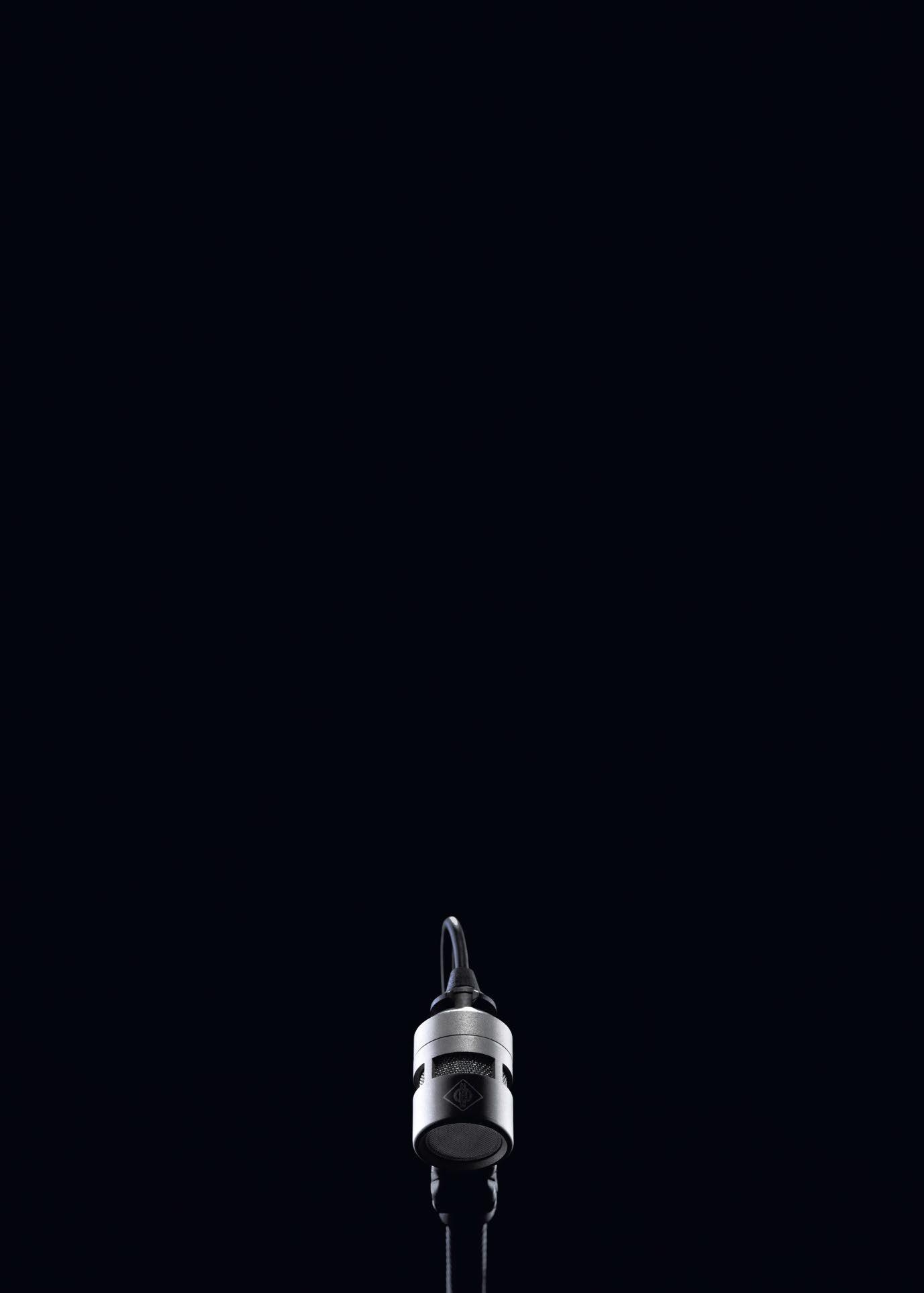
Youth Production Network (YPN) supports eight production areas including Interstage, Pyramid, Other, Acoustic and Park Stages, Williams Green, Silver Hayes and the BBC Introducing Stage at Glastonbury Festival 2022.
 Words: Rachel Haughey Photo: YPN
Words: Rachel Haughey Photo: YPN
Glastonbury Festival 2022 will go down as the most iconic gathering in its 12-year history, with excited crew travelling from as far as Berlin, Germany to reunite, stand up and make their mark.
Forming the biggest ever festival training team to date, YPN crew had opportunities to join exclusive backstage tours, and supported eight production areas including Interstage, Pyramid, Other, Acoustic and Park Stages, Williams Green, Silver Hayes and the BBC Introducing Stage.
Seasoned YPN veterans provided strong team support for those emerging from the pandemic for their very first festival experience. The YPN 2022 Crew included students from
dBs Institute, BIMM Institute, University of West London, London College of Music, City College Plymouth and Edinburgh Napier University. Emerging raw talent also joined from local communities across the South West including Frome, Bristol, Taunton, Totnes, Plymouth and Cornwall.
YPN Crew Chief, Jamal Maxey said: “It was a privilege to not only be at one of the greatest festivals on the planet, but also connecting with wise veterans and the new generation – reminiscing about who we have lost, the challenges that were overcome, and the reasons for optimism.”
YPN first time crew, Louis Bloomberg, shared his experience: “Joining the YPN crew
gave me the opportunity to get my foot through the door and gain a better understanding of how the music industry works.”
He added: “With it being my first time attending Glastonbury, the experience was better than I could have imagined, I came into the experience with a general aspiration to work in the live music industry but through my varied roles, I’ve found that I’d love to work in the live events and production industry.”
Officially back onsite, global YPN crews from across the world are stepping up as the new generation of inspirational production leaders, and 2022 has marked the launch of an exciting new production era to come. www.ypn.international






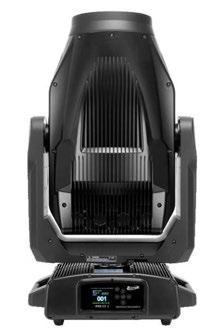
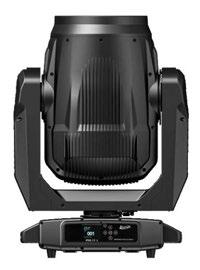



















On the front line of the industry’s move to a more sustainable future, having worked on Glastonbury Festival as well as consulting for Coldplay, Shawn Mendes, and the Co-op Live, Luke Howell highlights how Hope Solutions is primed to assist in bringing sustainable practices to the live events sector.
 Photos: Hope Solutions Words: Luke Howell
Photos: Hope Solutions Words: Luke Howell
I was born in East Anglia into my parents touring circus – Croissant Neuf – which, in the mid ‘80s, decided to ditch generators and switched to using renewables such as solar, wind and recycled batteries to power the entire show. In 1992, during the Rio Earth Summit, my parents took the circus to a vast sustainability event at Birmingham’s NEC called The Green Show where they realised that sharing information about the environment was essential but needed to reach a wider audience, so the circus evolved into a touring eco-exhibition centre – The Green Roadshow.
From a young age, I was immersed in environmental campaigning and sustainable
event production as if it was the norm rather than being something to switch over to and I was fortunate to grow up touring the UK and Europe surrounded by some of the brightest minds in the sector, learning many of the wider concepts and considerations relating to sustainability as well as delivery of world class event production.
As a teenager, I became interested in production, and started to work on projects outside of those with my parents such as The Greenfields at Glastonbury. As well as working at Edinburgh Fringe and other festivals, I launched my own event – Croissant Neuf Summer Party – where between 2007 to 2013, we put on a truly carbon neutral event and
hosted artists such as Ed Sheeran on a solar powered stage.
Working on other people’s projects made me realise how little was being done with regards things, such as energy efficiency and power management, waste and recycling and low carbon transport. Around this time, with events being more seasonal, I also worked in other sectors such as eco-construction and renewable energy, which gave me an even broader range of knowledge in sustainability.
In 2015, after working on the European Green Capital in Bristol, I gradually began to focus on becoming a sustainability consultant, and as such, I became a Fellow of IEMA, Chartered Environmentalist and Fellow of the RSA. It was around this time when Hope Solutions was born.
Or iginally, we worked mostly on festivals, along with various pieces of work within music, visual arts and theatre. Over the next couple of years things got busier and I worked in collaboration with a handful of others in the industry as project scope grew – notably Rob Scully and Paul Schurink of ZAP Concepts and Tim Benson of Smart Power UK. In 2019, the team grew with Emily Ford, former sustainability coordinator at Live Nation and Festival Republic, joining the team.
We were all set for an extremely busy 2020 when the COVID-19 pandemic struck and overnight, like many others in the industry, we lost around 90% of our work. In its own way though the time and headspace that the pandemic afforded us meant I was able to take stock of things and reset and Hope Solutions started to find other avenues of work within the wider media and entertainment industry –working with suppliers and businesses in the entertainment supply chain such as digital services and logistics.
Fast-forward another couple of years and Hope now has several extremely talented and knowledgeable teams working on some major

projects across the industry. We generally do our work in the background so not everyone has heard of us but we believe action speaks louder than words so we’re busy just getting on. Someone recently described us as ‘the industry’s secret weapon in tackling climate change’ – a title we are most proud of. We are not a campaign, charity or membership organisation, we are specialist technical consultants with deep roots in entertainment, environmental science and climate action.
When Hope started people were not quite so receptive to the issues we were raising but things were starting to change pre-pandemic and haven’t really slowed. I remember David Attenborough’s Blue Planet showing plastic waste in the oceans being a bit of a turning point in 2018, when suddenly people wanted to do their bit. The climate crisis hasn’t gone away, the effects are only getting worse and more visible so most people we speak to want to do things differently and reduce the negative impacts associated with some parts of how the industry operates. Increasingly people want to take a science-led approach backed up by recognised standards and best practice, which is our area of speciality.
The entertainment industry is one of the most creative on the planet but there are still plenty with the ‘but we’ve always done it that way’ mind-set. But the general mood seems to be one of open optimism. There are still a number of misconceptions we see around the topic such as assuming that anything to do with sustainability must also be expensive, not to mention teams jumping into offsetting before understanding what their actual impacts are or signing up to pledges or campaigns without a
plan. My advice is that not everything needs to happen today; it’s a process.
There is an argument that doing something is better than doing nothing, however we are at a point where it is essential to tackle some of the issues in a serious way and to do so with a measured approach that builds long-term resilience.
One starting point could be what we do with many of our clients: measure, eliminate, reduce, mitigate, offset, and repeat. With data and evidence then proper changes can be made and real reductions achieved. The other thing that is essential is broad communication with all the stakeholders involved in a project or tour – it’s not enough for a band, artist and production team to do it alone, it needs the buy-in from labels, promoters, venues, suppliers and the fans.
In general, most carbon emissions come from travel, transport and energy – anything linked to the extraction and burning of fossil fuels. These are some of the biggest areas that need to be tackled and can be one of the best ways to reduce the associated impacts. Use less, travel with less, be more economical with what you are using and there will be a financial and environmental benefit. We are spending a lot of time supporting the industry to use its position with global audiences to highlight the climate crisis without it feeling hopeless. We don’t want there to be less tours, concerts and festivals, if anything, there’s a strong argument for there being more and taking shows to people to help reduce fan and audience travel, just as long as the tour itself is as low emissions as possible.
www.hopesolutions.services
A blast from the past - photos from Luke Howell’s life including sights of the Croissant Neuf Summer Party and its solar-powered stage as well as Howell with his parents and their touring circus.






Having learned a range of technical skills during 3T’s latest free, practical training course – which helps people from underrepresented gender and ethnic groups gain the skills to begin careers in the live events sector – recent graduates have developed into all-round tour technicians. Since graduating, 3T’s class of ‘22 have demonstrated their utility, delving straight into the dynamic world of live events with hands-on experience at festival sites, venues and houses of worship, as well as touring campaigns throughout the summer months. www.3t.charity
“As part of the 3T programme, I did some work experience at Amazing Grace and now I'm now one of their regular technicians. Since graduating the course, I have been a FOH Engineer for the Rabbit Hole Stage at Glastonbury Festival – which, as well as being a weird and wacky place – was a great learning experience. I was able to meet and network with lots of other fellow engineers and technicians on site. Other opportunities include assisting with backline and tour management at Koko and Soho House for Cory Henry's UK run. I also got to work a show at Ronnie Scott's, which was a dream come true! Lastly, I engineer for a church called Global Harvest in Dartford regularly. I'm really open to seeing where all these opportunities take me. I love working as a sound engineer but I’m open to exploring tour managing and backline roles in the future. Production management is also something I'm seriously considering because it seems like they do a little bit of everything!”
“My passion for music runs deep and is connected to everything I have done so far professionally and personally. During the 3T course, we were treated equally and received a lot of respect from the tutors, guest speakers and colleagues. It was an amazing time and I highly recommend it to everyone that wants to get into the music-creative industry. I learned to work in a team and to find creative solutions on stage and off stage. From how to make MIDI jacks from scratch to developing my skills tuning and building guitar racks and drums kits.
I also learned to love cabels. The advice that sticks with me is to ‘always appreciate your personal space, be your true self and it’s cool to be different’. Since graduating, I have found work experience with good people and have been involved in several exciting projects!”

“I learned and developed skills in the basics of audio, signal flow and sound engineering, lighting (who knew universes had more meanings?!), playback and aspects of tour and production management on the 3T course. We also learned fun stuff like cable making and coiling and how to open a beer bottle without an opener. Since graduating, I have thrown myself into any and every opportunity available. I’ve been on tour with Alabama 3, shadowing their tour manager who is one of the 3T tutors.
I have also shadowed the crew on the Skunk Anansie tour, and most recently, been to Wilderness festival where I shadowed a FOH engineer.”
3T (Tour Tech Training) alumni share their next steps following graduation…
“Everyone involved with 3T has been super supportive and honest about their experiences. One of the biggest things that resonated with me is taking care of yourself whilst being on the road and staying connected to your community. I have been busy with a few festivals and events at various venues. So far my experiences have been great and extremely physical! I like that no project is the same. It has also been refreshing to bump into other people that I have met through 3T at events. While my background is originally in audio, since completing the 3T course, I see myself on the lighting designer or sound engineer route as both of those roles are a blend of technical and creative skills.”


“Since graduating the 3T course, I have worked as an Assistant Stage Manager for Parklife’s main stage with Engine No. 4 and as a Production Assistant at Bluedot. I also volunteered as a Tech Production Assistant at the Boardmasters Festival. I love working with people and enjoyed those big scale festivals, especially as I had the opportunity to put the skills I’d learned with 3T to the test by RoboSpot operating and building a video wall at Bluedot. I wish to get more involved in lighting, project management, stage management, and production management roles – I would also like to work with 3T to support people who want to start their career in the live music industry.”
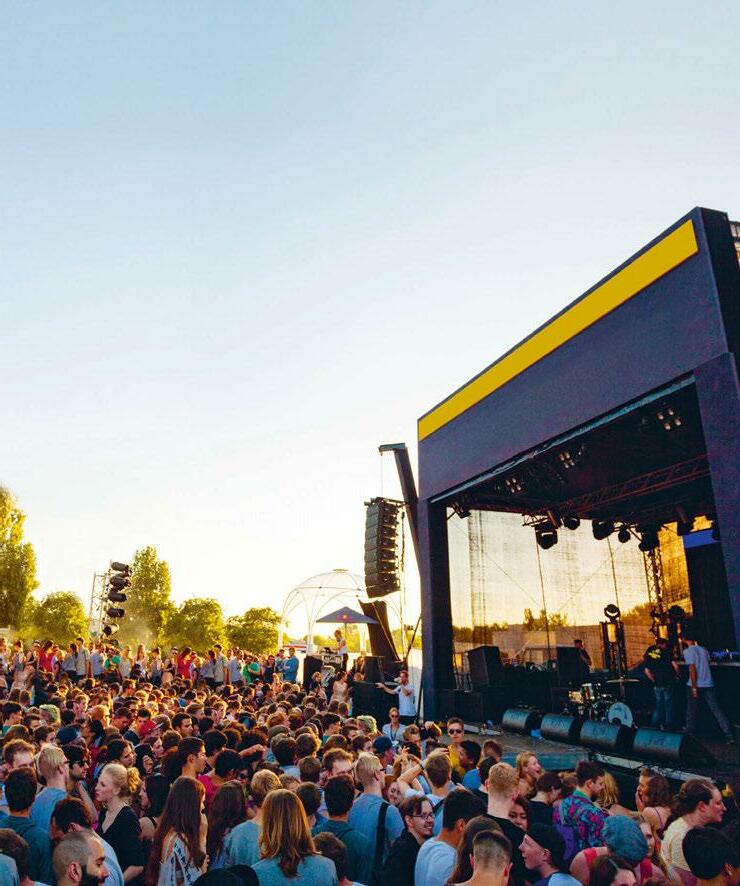


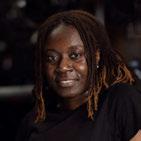







































































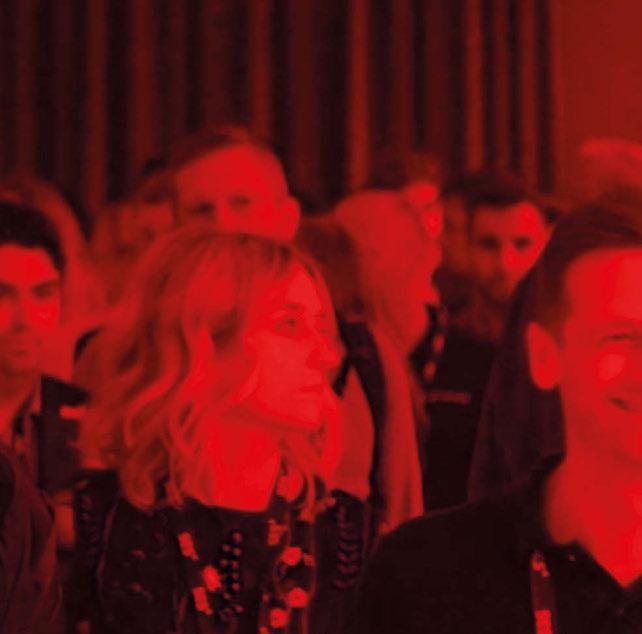

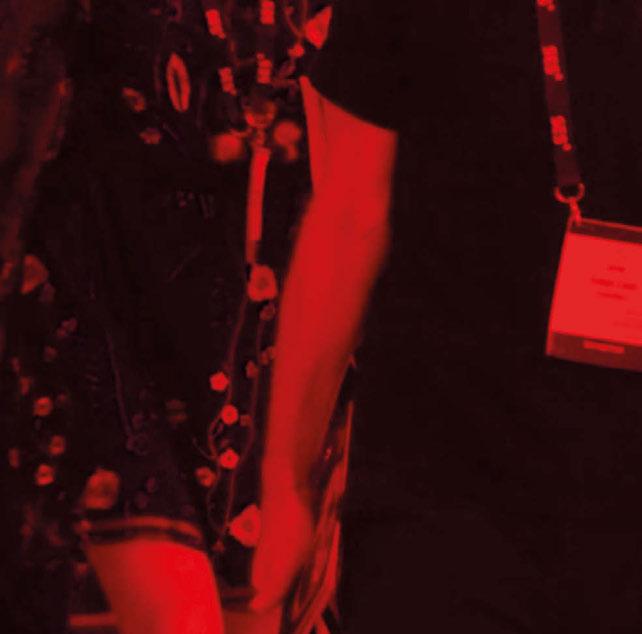



Music Venues Trust (MVT) Strategic Director, Beverley Whitrick takes the hot seat.

What’s behind the rise in venues adopting community business models?
“Music Venue Trust (MVT) has worked for the past eight years to gain recognition for the cultural, social and economic value of grassroots music venues (GMVs). Unlike other cultural buildings, GMVs are treated as profitmaking businesses in most legal contexts even though the role they play in developing talent and new music is economically lossmaking. The move to change to CICs, CBSs and other recognised non-profit management structures is part of the solution but needs to be complemented by tackling the fact that 93% of GMVs operate in commercial rented properties. This means that they are subject to market forces in a way that other cultural buildings are not, leaving little money to invest in their core work. The average lease for a GMV has 18 months remaining and we are seeing an alarming rise in non-renewal of leases, resulting in venue closures.
“GMVs need certainty to plan and meet the demand, not only for their creative work but also to contribute to their communities and society by meaningful advances in access and sustainability. This is the research behind the Own Our Venues campaign and the formation of Music Venue Properties. MVP will be a benevolent owner of the buildings and the existing venue teams will continue to run them, with more secure finances.”
How could this trend benefit the wider live production industry?
“MVT has undertaken a piece of work analysing how much of every pound spent on tickets in the grassroots sector can be spent on creative activity. In a GMV that operates in a commercially rented property, 46.6p of every £1 disappears immediately in rent, taxes and rates, leaving only 53.4p to be spent on putting on gigs. This means that overall budgets for staff and shows in these venues are low. If a venue is run as a not-for-profit and occupies a building owned by a benevolent landlord, which
music venue properties have been designed to be, then the figures look very different. For every pound spent, only 11p goes to rent, leaving 89p to be spent on the core creative activity. Not only does this give the venue money to physically improve the venue but it means that there is more money available for paying the venue team and the artists’ teams.”
How important is securing the future of GMVs?
“If a town loses its GMV it is expensive to replace and it takes someone with passion and financial backing to spearhead such an undertaking. MVT focuses its energy on preventing closures and helping existing venues to operate more effectively. The ownership of the buildings in which GMVs operate is the single biggest obstacle to their sustainability as cultural hubs, so community ownership of the bricks and mortar plus community supported entities operating them makes so much more sense. We have been delighted that so many parts of the music industry recognise this and are prepared to support the Own Our Venues initiative. The music community investing in itself can only make it stronger and, hopefully, pave the way
for greater collaboration in nurturing talent across the UK.”
What does the future look like for MVT?
“In addition to the Own Our Venues campaign, we have been developing our team to ensure that the charity is equipped to deal with our growing workload. We launched a new membership model for the Music Venues Alliance, which enables us to pay for some of our core member services without the need for external funding, meaning that we can direct attention where it is most needed without reference to anyone else’s agenda. We are developing a whole host of member resources too. Our Live Projects, in partnership with companies including The National Lottery, Vuse and FreeNow, enable us to bring artists to venues they may not be expected to play by covering their fees. We are also currently working on the eighth edition of our national networking event Venues Day, which will be held on 18 October 2022 at Hackney Church, London. This is the largest gathering of grassroots music venues and relevant stakeholders in the UK and will cover all of the elements above, as well as being the primary networking event for the sector.”
“The music community investing in itself can only make it stronger and, hopefully, pave the way for greater collaboration in nurturing talent across the UK.”
Beverley Whitrick






